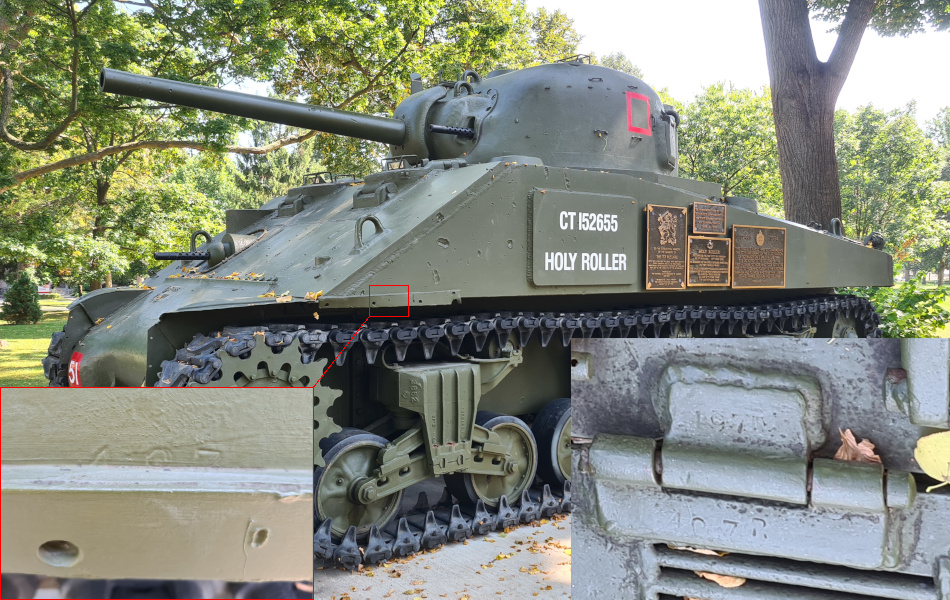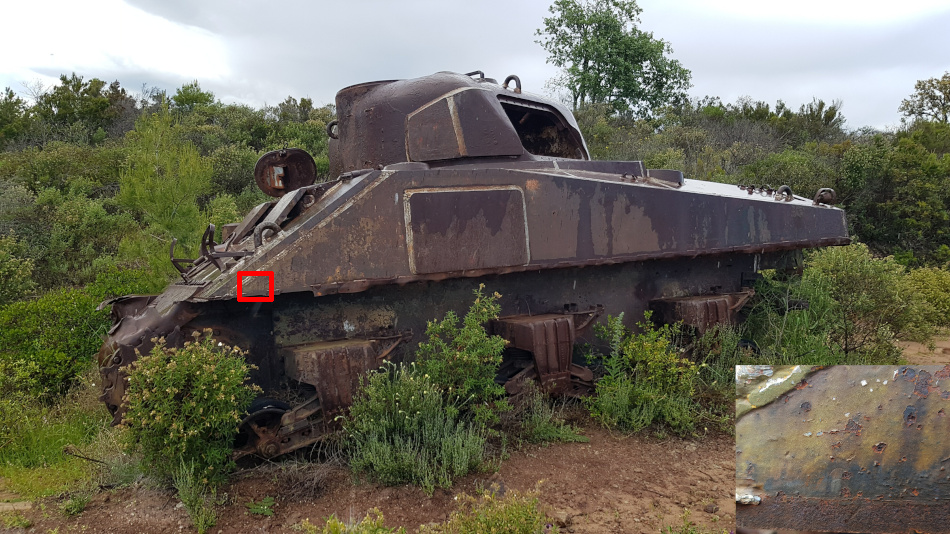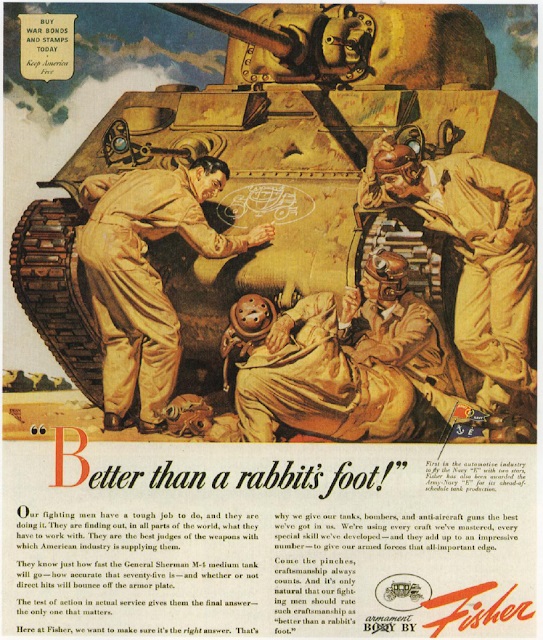Most of the information on this page is courtesy of Joe DeMarco. Note: some of the information on this page was compiled using a technique informally referred to as "counting heads". It is based on the ongoing study of period documents and photographs, as well as surviving Shermans. Due to the limited nature of available reference sources, some of the information presented here must be considered as "educated guesswork."
First of all, you have to
identify the tank as being an M4A2(75) with small hatches. Please visit
this
page to do so.
Fisher Body produced 4614
M4A2(75) with "Dry Stowage" from April, 1942 through May, 1944. The
vast majority of them were of the so called "small hatch" type
discussed here. So far, the authors have found no official records that
provide exact production figures. It is thought that the transition to
the large hatch version with 47° glacis (not presented here)
took place in November, 1943. Our best guess of the production figures
would be 3614 small hatch and 1000 large hatch.
Nearly
all M4A2(75)s were provided as Lend Lease to the British Commonwealth,
the USSR and France. In addition, the US Marine Corps was supplied with
493 units.
Production Order T-3049
: 350 tanks manufactured (April - August 1942)
Production Order T-3195 : 2000 tanks manufactured (August 1942 - March 1943)
Production Order T-3318 : 275 tanks manufactured (March - May 1943)
Production Order T-3608 : about 986 "small hatch" tanks and 714 "large hatch" tanks manufactured (April 1943 - February 1944)
Production Order T-3195 : 2000 tanks manufactured (August 1942 - March 1943)
Production Order T-3318 : 275 tanks manufactured (March - May 1943)
Production Order T-3608 : about 986 "small hatch" tanks and 714 "large hatch" tanks manufactured (April 1943 - February 1944)



The rapid expansion of M3 Medium Tank production required more power plants than the limited supply of Radial tank engines could provide. Consequently, the Ordnance Department cast about for other possibilities. In August, 1941, General Motors was contracted to perform an experimental installation using M3 Lee Serial Number 28, which was pulled off the line at Chrysler and shipped a short distance to GM’s Detroit Diesel Plant. The configuration combined two "off the shelf" GM 6-71 diesel truck engines that were “coupled together by means of a transfer case delivering the doubled power to a single driver shaft.” Together the engines developed about 400 horsepower. SN 28 was evaluated at Aberdeen Proving Ground in Maryland, and in October, 1941, the twin diesel engine was designated the "GM Model 6046," and authorized for production as an alternate power plant for the Medium Tank. Above shows SN 28 at APG in November, 1941. The upper rear hull plate (1) was reconfigured by being elongated and mounted on an angle in order to accommodate and protect the rear mounted radiators. The engine access doors in the lower rear plate of the original M3 design were eliminated, and instead a pair of mufflers were mounted across the plate. Note that a sheet metal exhaust deflector (2) was installed on the pilot. The engine was serviced through a rather large pair of doors on the engine deck. This configuration was carried over to the Sherman design as the M4A2.

Above shows a GM Model 6046 twin diesel on display at the Tank Museum at Bovington. Note the transfer case indicated by the arrow. The size of the twin engine configuration necessitated a number of changes to the layouts of both the engine and fighting compartments. For instance, the addition of the transfer case made the power pack longer than the engine compartment. Consequently, the firewall was altered to permit the transfer case to protrude into the fighting compartment. From the start the US Army had determined that it would employ gasoline powered Shermans in its armored units, so production of the diesel was primarily intended to satisfy the requirements of the Lend Lease Program. Photo courtesy of the late Massimo Foti, a fine photographer, and friend to Sherman Minutia.

In August, 1940 the US Government financed construction of a dedicated tank plant in Warren, a small township outside of Detroit, Michigan. The "Detroit Tank Arsenal" was operated by the Chrysler Corporation, and was set up for the production of 1000 medium weight tanks per month. The plant produced 3352 M3 Medium series tanks from July, 1941 through August, 1942. In July, 1942, DTA began production of the M4A4 model of the Sherman Tank. Another massive and dedicated tank plant with a 1000 medium tank per month capacity was authorized by the War Department in November, 1941. The 452,000 square foot Grand Blanc Tank Arsenal was operated by the new corporate entity, the "Fisher Tank Division" of General Motors. The contract also provided funding for additional facilities at an existing automobile plant in Flint, Michigan. The photo above was part of an informational series on the conversion of auto plants for war production, and shows "workmen who once built Chevrolets" welding on the Fisher pilot model of the M4A2. David Jackson's fine website "The American Automobile Industry in World War Two" explains that, "Prototype work was done... at Fisher Body #1 4.5 miles north [of the Tank Arsenal] on Saginaw Street. The first tank came off the prototype line April [1942] along with three others and in May sixteen more M4A2s came off the Flint 1 prototype line, allowing Fisher Body to deliver tanks two months before scheduled, and before the Grand Blanc plant was finished in July."

The photo above shows the pilot M4A2, nearing completion at the Fisher Body Flint No. 1 plant. Throughout production Fisher appears to have used something akin to duct tape to seal up gun barrels and other voids for shipping. Note how the fixed and coaxial MG holes have "disappeared." Contrary to the caption of the previous photo, the workmen here did not build Chevrolets; rather they stamped out and constructed body parts for the Buick automobile assembly plant located nearby. The Fisher Tank Division was tasked with aiding in the design and production of a Tank Destroyer, and the hull of the T35, the first iteration of what became the "3 inch Gun Motor Carriage, M10," can be seen as the second "tank" in line. Note the "missing" bow machine gun, and the protective plate on the 3-piece differential housing. The addition of the plate appears to have been in anticipation of the superior 1-piece differential housing that had been designed and was just entering the Sherman production pipeline. Like the Fisher M4A2 pilot, the T35 was shipped to APG immediately after it was completed in April 1942.

The Fisher pilot M4A2, Serial Number 2305, USA 3014311 was the first model of welded hull Sherman produced, and after completion, was immediately shipped to Aberdeen Proving Ground for evaluation. The view above, dated April 15, 1942, shows the "method of blocking" for shipment by rail. The purpose of the U-shaped fittings (1) affixed to the front and rear bogies, and seen in a number of photos of early combat Shermans, is evident here. In some cases it was noted that these were tied down too tightly on the railroad car, which overly stressed the volute springs. The rear most turret splash section (2) can be seen to have been assembled by welding, and portends the use of a number of fabricated as opposed to cast components in the construction of Fisher built M4A2s. What we informally call the "bent rod" hull lifting ring (3) was used on early production Shermans, but was soon replaced by a casting with a rectangular base by most of the builders, including Fisher. The rear most engine deck panel was secured with 11 bolts (4) on early production M4A2s, but, for user convenience, this was reduced to 6 bolts shortly thereafter. SN 2305 is thought to be the only welded hull Sherman that was constructed with a step (5) in the sponson armor. Note that 2305 can be seen with a standard D50878 turret with gunner's periscope. As best we can determine, only a few of the earliest M4A1s produced by Lima Locomotive and Pressed Steel Car were built with turrets with rotor sights.


Here we show in more detail the odd step (arrow) on 3014311, the Fisher M4A2 pilot. To the best of our knowledge this peculiar feature was limited to just the one welded hull pilot. Perhaps the step was unintentional, caused by an error in the engineering drawing which created a step when the 2 dimensional drawing was translated into the 3 dimensional hull? As can be seen it would have been quite complex to build this intricate shape, requiring additional labor and materials, for no practical benefit. In fact the step would have created a shot trap and as such a potential vulnerability in combat. Regardless of the cause, it appears that it was rectified immediately because this step did not appear on subsequent Fisher hulls.

Here
we have a snapshot that we "won" on Ebay in 2022 showing USA 3014312.
"APACHE" would have been the first production Fisher M4A2, and we would
judge that it does NOT have the "odd step" seen on the pilot.
"Melichercik by M4 Tank (General Motors)" is all that is written
on the back. "AFS" is painted inside the star on the turret which
would suggest that the location was the Armored Force School at Ft.
Knox, Kentucky. Most likely "APACHE" was with the Demonstration
Regiment's A Company like "ASP" and "ATILLA" which we shall discuss
going forward. The foliage would indicate summertime 1942 but perhaps a
bit later than some of the other AFS photos, since we believe that this
tank would have been built with flat block rubber tracks, and that the
rubber chevrons seen here mounted backwards were replacements. The
inside of the commander's hatch appears to be (re?)painted olive drab
rather than the white seen in photos of some other early Fishers. As
with the pilot, the Registration Number seems to be in a darker color,
probably black. The May 1942 photos of ASP USA 3014316 and ATILLA
3014317 show a much lighter color (inset). The evidence suggests that
Fisher begin using blue drab for the RN very early on and continued
with it throughout production. A close look at the bow gunner's
hatch shows the handle mounted towards the rear and on an angle.
"APACHE" can be seen with a 1-piece differential housing which is
"flat" at the top. Some Lees can be seen in the background with at
least one being a cast hull M3A1.
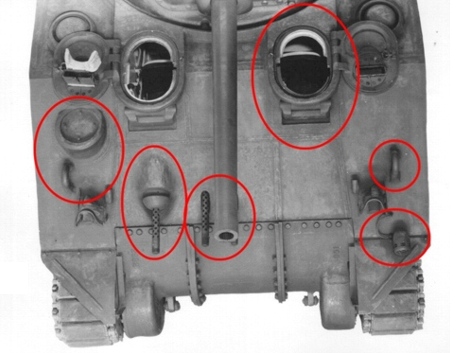
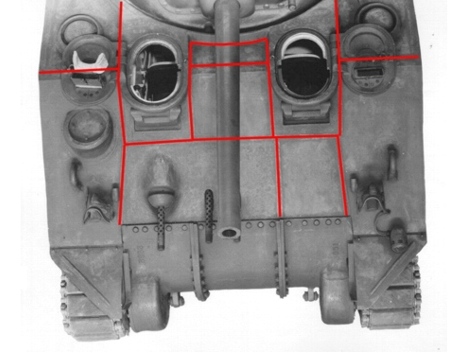
The two photos above show several items that are specific to very early Fisher built, small hatch M4A2s. On the left-side photo circled in red, from left to right, the cast antenna bracket and the crude "bent rod" lifting ring, the bow and fixed machine gun "plate," the cast drivers' hoods with direct vision slots, the other "bent rod" lifting ring, and the siren affixed to the mudguard. The right-side photo shows the construction of the front glacis with the red lines indicating the weld joints. Note that the "plate" that includes the bow and twin fixed machine guns was actually a casting, whereas the other flat sections of the glacis were armor plates. We think of this as a "7 section glacis pattern." On March 5, 1942, even before the first M4A2s rolled off the assembly lines, the Military Characteristics of the M4 series were revised to eliminate the two fixed machine guns. However, similar to some of the early Lima and PSC M4A1s, a few of the first few Fisher M4A2s were built with the fixed MGs installed or with the open holes. On the other hand, Pullman Standard also had its first M4A2 accepted in April, and photos of their first and succeeding units show neither the fixed MGs nor open holes.

It is thought that SN 2305 was the only M4A2, or welded hull Sherman for that matter, that was constructed with the "step," and the drivers' hatch handles welded on towards the rear and on top of the hatch "bumps." Succeeding units appear to have been built to a later revision of the design, where the upper sponson plates reflect the "usual" welded hull configuration. In a previous photo, the hull of the pilot T35, USA 4027647, can be seen as the second unit on the line at the Fisher Body Flint No. 1 plant. Consequently, we thought we might discuss it a little, since it was obviously based on an early Fisher M4A2 hull, but with an open top turret mounting a powerful 3 inch anti-aircraft gun. In this top view, note the "normal" way that the sponson plates are joined in front of the fuel cap bullet splash (1). The handles (2) of the drivers' hatches have been "relocated" to what became the standard position. Counting heads suggests that Fisher mounted the grouser cover plates (3) on top of the armor from the beginning of M4A2 production in April, 1942 to the end in May, 1945. We mention this because counting heads suggests that Pullman installed these cover plates flush with the armor surface, which provides a minor way to differentiate between the two producers' M4A2s in some photos. The rearmost engine deck plates of early M4A2s were "indented" (4) for reasons we have yet to discover. This was obviously unnecessary, since the indents appear to have been eliminated in July, 1942 at Fisher, coincident with the reduction in the number of bolts securing the plate from 11 to 6.

Fisher also completed the T35E1 pilot, USA 4027648, in April, 1942 and shipped it to APG. The Tank Destroyer Board wanted to use the lower hull, suspension, engine and power train of the M4A2, but as can be seen above, the upper hull was completely redesigned. The height, compared to the Sherman was lowered by 14 inches. In order to reduce weight and gain speed, the side and rear armor was reduced to a thickness of 1 inch, but mounted on an angle to improve ballistics. The glacis plate was the same as the M4A2's - 2 inches thick. While the T35E1's front plate can be seen in another photo from this series to have been composed of 3 sections, the idea of the design was to use a single plate for the glacis. Most significantly the glacis plate was "clean." The Sherman's protruding drivers' hoods and antenna bracket were eliminated, and the T35E1 provided a hatch in the roof of the hull, although only for the driver. This was essentially the "front end" concept submitted by Fisher for the Second Generation redesign of the Sherman about a year later. The fittings on the rear engine deck suggest that it was the intention that the tow cable would be coiled there. There may have been some debate about this, as the cable fittings can be seen on the rear decks of a few early Fisher and Pullman M4A2s. This would have added considerable weight to a removeable deck plate, and ultimately, the cable was mounted along the length of the hull on the left side as seen on the M4A2 pilot. In any case, a number of changes were made to the T35E1 design, particularly regarding the turret, but in June 1942, the Ordnance Committee approved standardization of "3-Inch Gun Motor Carriage M10." Fisher began M10 production a few months later in September, 1942.

Returning to the M4A2, here we see the fourth one completed by Fisher, S/N 2308. Buick, another division of General Motors, began making power trains in early 1942. From the outset, they constructed their units with the recently designed one-piece (E4186) differential cover, a great improvement over the three-piece differential of the M3 Medium. (The differential housings of many surviving Shermans are seen with "BU" among the casting marks, which we take to signify Buick.) S/N 2308 was used to test one of the first Buick power trains. Counting heads suggests that Fisher completed the transition to the 1-piece differential by June, 1942. The M3 type bogie units as seen on 2308 were seriously overtaxed by the Sherman, and sufficient supplies of M4 bogies became available so that Fisher was able to complete the transition to them by September, 1942. Note that while this tank has the tow cable mounted in the standard location, it was built with additional tow cable fittings on the rear deck. This example lacks the standard rear tow cable fitting that was was provided on the pilot model; instead the cable appears to be secured to the rear lifting ring by a shackle. An odd feature of 2308 is the white painted hatch interiors. No doubt they would have been repainted in Olive Drab, if the tank had ever been sent overseas. As it was, 2308/USA 3014314 was an asset of the Armored Force Board at Ft. Knox at least until February, 1945 when it was requested that it be removed from the Motor Pool to make room for more current test vehicles.

We
have recorded some textual listings for a few of the early Fisher M4A2s
that were shipped to Ft. Knox, Kentucky for evaluation by the
Demonstration Regiment of the Armored Force School. These include SNs
2307, 2308, 2311, 2314 and 2315. Here we have a somewhat washed out
color photo of what we assume to be SN 2308, since it has a 1-piece
diff, and some fuel has spilled down the side revealing the numbers
"314," which we take to equate to USA 3014314. Unfortunately, many of
the Signal Corps color photos have generic captions that provide
absolutely no "who, what, where, when." For instance, the caption of
this photo is "Picture of M-4 Sherman Tank." It would appear that a
number of 8 X 10 color transparencies were turned into the Pentagon
without captions, and released by the Bureau of Public Relations post
war.
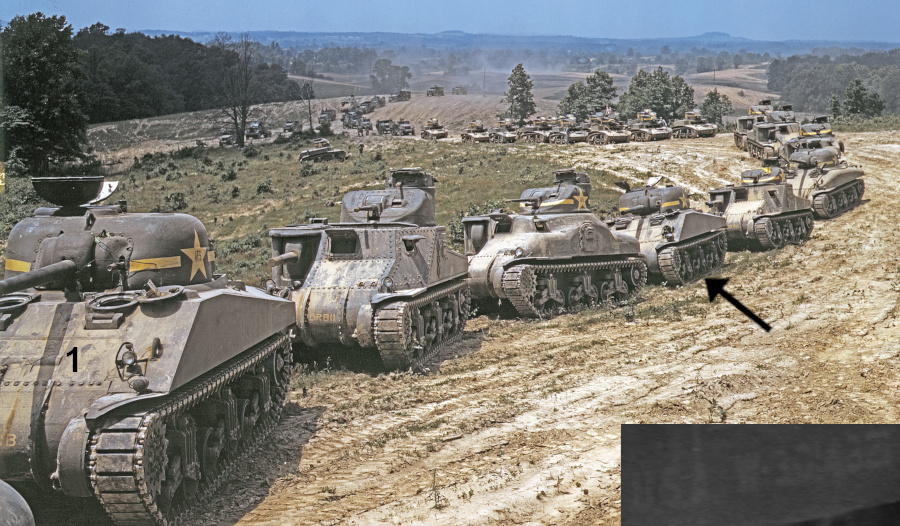
One of our favorite color photos, showing some of the Demonstration Regiment's Shermans, Lees and Stuarts on a nice Summer day, no doubt in 1942. The tank with the one piece differential housing (arrow) is probably SN 2308. The lead Sherman can be seen with the "bump" (1) on the glacis casting, and one of the fixed machine guns installed, while the other hole is taped up. At first we thought this unit might be the fourth Pullman M4A2, SN 908, since photos show it had the "bump." However, that one was sent to APG for Acceptance Test in the Summer of 1942. And besides, the fixed MG holes were closed on SN 908 and it had a 1-piece differential housing. The USA Number of the Demonstration Regiment M4A2 can be seen painted on, and we were able to manipulate the photo where it was possible to discern that it began with "30143," possibly 3014321 (inset), which is listed in a text document as SN 2315 of B Company of the Demonstration Regt., "10/27/42, engine failure." Indeed, this is the only example of the "bump" on a Fisher built Sherman that we are aware of. Should readers know of any other photos, we would be pleased to see them.

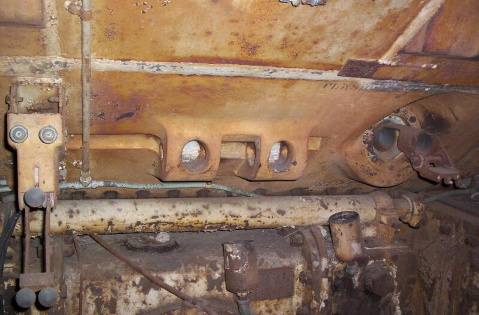
Above shows interior and exterior views of the "bump" on a surviving Sherman, the first ALCO M4A2. It can be seen that this particular glacis casting was made to hold the twin fixed machine guns that were part of the original M4 design. The fixed MGs had been eliminated in March, 1942, before production of welded hull Shermans had begun, and one can see on this example that the holes were simply sealed up by welding. At first we thought that the use of the glacis casting with the bump was short lived, and limited to a few early M4A2s, along with the two Ford M4A3 pilots. We would note that in the few period photos showing the "bump" on M4A2s, as well as on the two known surviving examples, the tanks have direct vision. However, the bump has also been observed in a pair of photos of early 1943 production M4s thought to have been made by ALCO, and with the later type of drivers' hoods. We can only guess that the employment of these castings in the assembly of a 1943 production welded hull Sherman was a case of using obsolete, but acceptable parts that were on hand. At any rate, “the bump” provides us with an interesting and ongoing little Sherman mystery. (Photos courtesy of the APG Restoration Staff).

The photo above is part of a series that show tanks A8, "ASP," and A9 "ATILLA" of the Demonstration Regiment. From examining the other photos, we find that ASP was USA 3014316 and ATILLA was 3014317. These would have been accepted in May, 1942 and would have been the 6th and 7th M4A2s produced by Fisher. ASP can be seen with both fixed MGs installed, and appears to have the same "7 section glacis pattern" as on the pilot SN 2305. This is the pattern most commonly seen on the early Fisher M4A2s. On the other hand, ATILLA seems to show an 8 section glacis pattern, with a small bow MG casting, and a separate plate for the fixed MGs. These tanks have not yet been installed with the gunner's blade sight that became standard a month or so later. Note how the front fenders do not follow the contours of the 3-piece diffs, since they were made for the 1-piece jobs.

This interesting overhead view of ASP shows the configuration of the tow cable installed in the short lived rear engine deck position. M4A2s had 7 fuel/oil/water filler points as seen here. Because of the size of the twin diesel engines, there were no vertical fuel tanks in the engine compartment. Filler point 1 was for diesel fuel stored in the horizontal tanks. These were supplemented by a pair of reserve fuel tanks mounted on the engine compartment floor just below the horizontal tanks. The fuel capacity of the M4A2 was 148 gallons, compared to the M4/M4A1's 172 gallons. Point 2 provided for lubricating oil, and point 3 for water to the radiators. Of course these were mirrored on the right side, but they are in heavy shadow in this view. Point 4 was for the auxiliary generator (Little Joe), the same gasoline powered model as used on the radials. None are seen on this example, but pressed metal labels were affixed near each of the fuel filler covers to help the crews avoid contaminating the tanks with the wrong solutions. We confess that we have not been able to determine when these labels were first factory installed. For what it is worth, the first ALCO M4A2 was accepted in September, 1942 and can be seen with the "official labels," as can "Holy Roller" a Fisher built M4A2 that was also accepted in September. Little chains secured the fuel caps' removable hinge pins. It can be seen that the chain at filler point 1 is not connected to its hinge or "locking pin."
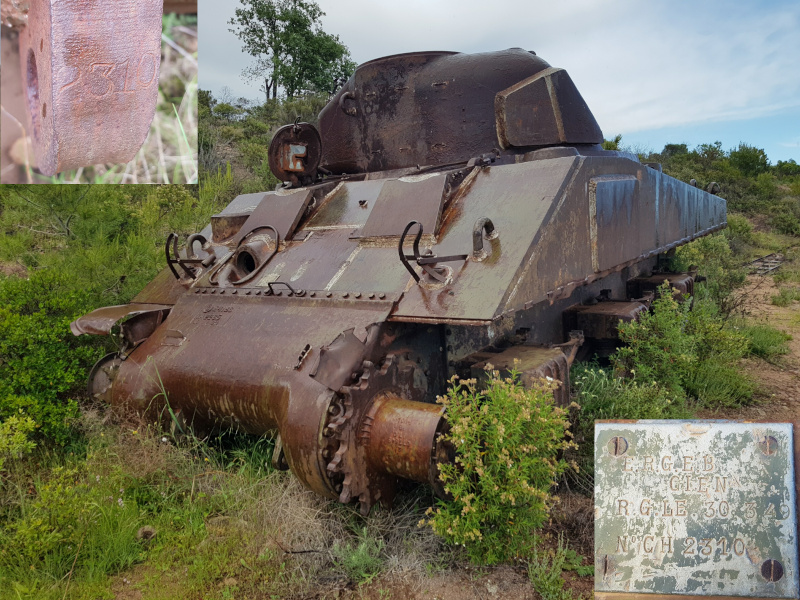
When we were informed recently that the tank shown above has Serial Number 2310 stamped on the rear towing lugs (left inset) and inside the dataplate frame, it became, for us at least, the oldest known surviving M4A2. Not only that, but Serial Number 2310 is an exact mathematical match to USA 3014316, the Registration Number of "ASP", "DR-A8" as seen in the photos of the two previous captions. A total of 525 M4A2(75)s that had been used by training units in the US were collected up and remanufactured from April through November 1944, and SN 2310 strikes us as one of them. We believe that the M3 bogies seen in the 1942 photos would not have been considered acceptable for a remanufactured Sherman and would have been replaced if they had not been earlier. Many remanufactured Shermans are noted with 3-piece differential housings such as "ASP" had originally, so that would not necessarily require replacement, but it obviously was at some point. We would note that there is a plate (right inset) screwed on to the front indicating that SN 2310 had been rebuilt by the "Etablissement de Réserve Générale du Matériel - Engins Blindés" in Gien on 30 March 1949. The turrets of early Fisher M4A2s such as "ASP", don't appear to have had any casting marks visible on their exterior surfaces. In the case of SN 2310, "D50878, (G in a shield) E" is visible inside on the "ceiling." From a very small sample, we believe that the earliest turrets produced by General Steel-Eddystone were cast in this configuration. In any case, if this turret with the "high" lifting rings is not original to SN 2310, it is certainly appropriate. With the paint worn away, we get an idea of the welded together construction of the glacis, including the filled in fixed machine gun holes. The "bent rod" hull lifting ring also shows to good effect.

We admit that we don't have any confirming photos of Fisher M4A2s with known good Serial or Registration Numbers past the twelfth one, but we would "project" that the first 49, built from April to June, 1942, SNs 2305 through 2353, with RNs in the 30143XX range, would have been constructed mostly with fronts composed of 7 section glacis patterns. Their antenna brackets, bow MG "plates," and front and side turret splash guard sections would "still" have been castings. Some may have had 1-piece differential housings, but we suspect all would have been built with M3 type bogies. A couple of these, SNs 2320 and 2349 were reported to be among the first 26 M4A2s received as Lend Lease by the Soviet Union. These are stated to have arrived "at a northern port of entry" in November, 1942. SN 2341, USA 3014349 is listed with the 81st Armored Regiment in a Maintenance Report from Camp Young, California dated September 18, 1942. And finally, we have SN 2318, USA 3014324 noted in a Disposition Report from Oceanside, California, dated September 4, 1945. We take Oceanside to be Camp Pendleton, where the US Marine Corps was seeking to dispose of this obsolete Sherman, probably one of the first M4A2s they received. At any rate, in an effort to conserve some of the nation's limited casting capacity, Fisher designed and began to substitute what are described as "fabricated" components for some of the original castings with which it began production. Their 110th M4A2 hull, which would have been accepted in July, 1942 had it been completed as a tank, was submitted to APG for a Ballistics Test during that month. It is mentioned that the hull's armor plate was supplied by Republic Steel Corporation. In this view, we can see the sharp angles of the fabricated turret splash sections (1). These appear to have been used exclusively by Fisher Tank, and are a sort of trademark of their small hatch M4A2s. One would think that the bullet splash (2) protecting the armored filler caps would have been fabricated, but the examination of surviving examples shows that these remained castings. Going the other way, the fabricated "bent rod" hull lifting rings of the early models were replaced by the castings shown here (3). For convenience, we refer to these as "padded" hull lifting rings.

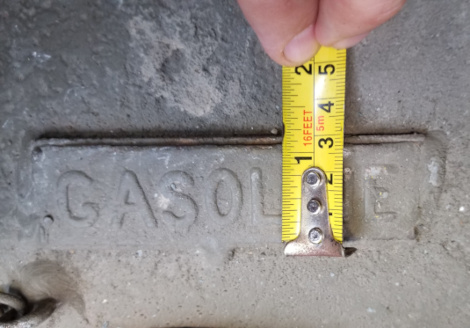

The above photos show an example of what we believe is an original pressed metal label as seen on a surviving M4A2. This is, of course, the "Gasoline" label for the auxiliary generator. The label itself measures about 1 1/8 inches in width, and 4 1/4 inches in length. The label appears to have been welded onto to a slightly larger pad which was welded on to the hull. We haven't as yet been able to measure one, but would judge that the curved ones (Diesel Fuel Oil, Lubricating Oil) are the same width, and span about 8 inches at their widest.
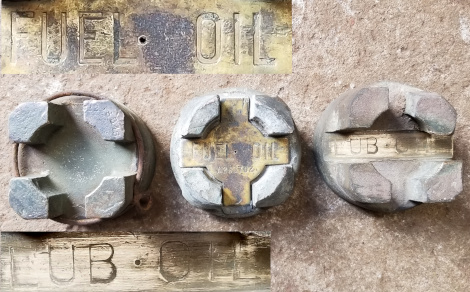

The armored filler caps protected a screw on cap over the filler necks of the various fuel, oil and water tanks. Pierre-Olivier photographed the examples shown on the left above from a surviving M4A2 diesel. They have a sort of "castellated" appearance, and two have the labels "FUEL OIL" and "LUB OIL." This type of inner cap appears to have carried over from the M3 Medium series. "FUEL OIL," which has been noted on the armored filler caps of a few M3 series diesels, is somewhat confusing, and the M4A2's exterior pressed metal label was changed to "DIESEL FUEL OIL," although it strikes us that "DIESEL FUEL" would have been sufficient. Our ability to count heads on these caps is extremely limited. Our best guess is that they were replaced in production in the Summer of 1943 with the "Fuel Tank Filler Neck, Filter and Cap" as shown in the illustration in the middle, and in the Korean War scene on the right. The new configuration was considered an important safety upgrade, and a Field Service Modification Work Order was released so that the new caps and filler necks could be retrofitted to Shermans in Tank Depots or in the field. Indeed, this was labeled an "Urgent" modification to be installed on all US Army Shermans in the UK before D-Day. As of Nov. 1, 1943, the Ordnance Department reported that "stock on hand" was 5897 kits.


Fisher M4A2 Serial Number 2420/USA 3020927 was produced in July, 1942 and was shipped to APG where it underwent an Acceptance Test in early August. The tank was widely photographed on the test tracks there as shown above. The Report notes that the M34 Gun Mount was manufactured by the Fisher Tank Division and was serial number 69. The gun was produced by another GM divison, Oldsmobile, which went on to manufacture most of the Sherman's 75 and 76 mm guns. Of interest is that the power train is listed not as Buick, but as Caterpillar #2C-216. Note the flatness of the differential housing with countersunk bolts running across the top. It is thought that the E4186 diffs designed and produced for Buick had a protective "lip" in front of the bolt strip. It is around this time that Fisher M4A2s begin to take on a rather consistent appearance characterized by the use of fabricated components. On this example, the glacis pattern has been reduced to 6 sections, with the fabricated bow machine gun socket (1) welded into a single plate. Note the distinctly sharp lines of the fabricated antenna bracket (2) and the turret splash sections (3). In the rear, one can see the original design of the sheet metal exhaust deflector with open sides (4). SN 2420 "still" has the "indented" rear engine deck plate, secured by 11 bolts (5). While photos of early Fisher M4A2s show the Federal Type 160 siren with the "V for victory" grill, by July it would appear that Fisher began to receive regular supplies of the larger Mars Signal Light Company siren (6). Period photos suggest that the Mars sirens predominate from then on, but the Federals continue to appear on some Fisher M4A2s. A gunner's blade sight (7) can be seen on SN 2420. The M4A2 was apparently designed without an external handle on the commander's cupola, and it is "still" lacking on 2420. However "counting heads" suggests the handle was introduced in July, welded on to the hatch half without the periscope (8).

Looking very much like SN 2420 of the previous caption, the M4A2 seen here is about to be installed with a differential housing/power train. In this case, the lip (arrow) would suggest a Buick made power train. We believe this photo was taken in July 1942 as production got underway at the new and gleaming Tank Arsenal in Grand Blanc. In this instance, a handle (1) is just visible on the hatch half of the commander's cupola. Throughout production, Fisher appears to have used both welded and pressed metal road wheels. The photos of SN 2420 showed that it had pressed metal wheels, but the unit seen here caught our eyes because it has some "unspoked" pressed metal wheels (2). We think of the unspoked wheels as the first version of the pressed metal road wheels which replaced welded spoke wheels on Chrysler Lees around March 1942. Chrysler soon replaced them with the standard spoked pressed metal wheels which they used on all of their Shermans until the end of VVSS production. In any case, the unspoked wheels are fairly rare and before seeing this photo, we had thought that they might have been confined to a few Chrysler Lees and the M4A4 pilot.

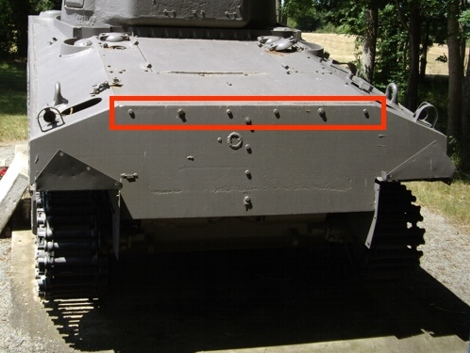
Counting heads suggests that in August 1942, in the interest of simplifying, Fisher lowered the number of bolts securing the rearmost engine deck plate from 11 to 6. The rearmost engine deck "indents" appear to have been eliminated with the bolt reduction.


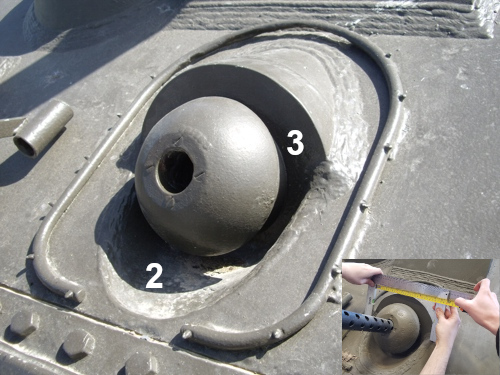
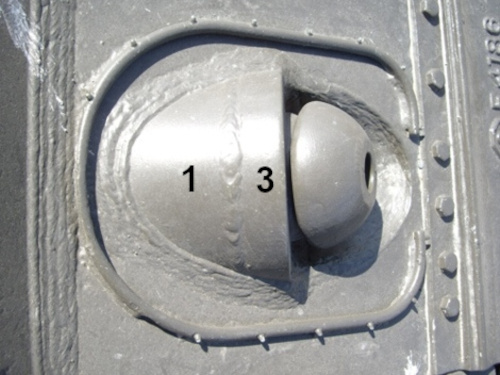

This interior view shows how the "Bow Gun Front" was welded to the upper and lower pieces to form the bow MG socket.


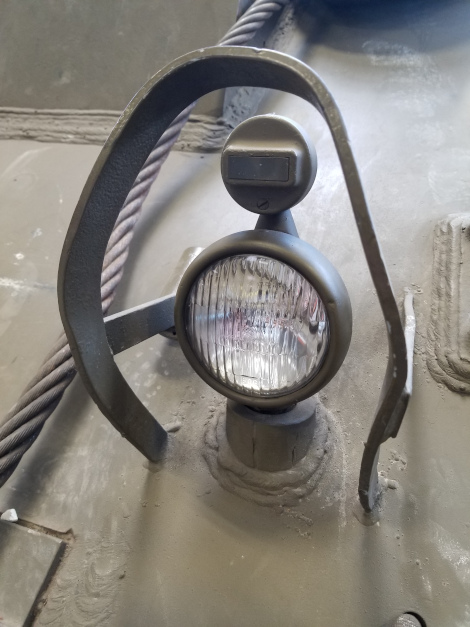
At the same time as the introduction of the other fabrications, Fisher replaced the cast headlight socket with what was basically a pipe with an outside diameter of 2 3/4 inches and 5/8-inch-thick walls (left). This is described in a Fisher parts document as "Boss Outer Headlight - Rt." or "Boss Outer Headlight - Lt." although the Part Number for both is "A-245386" since they are identical. These are small fittings, but we can confirm that we have seen this Part Number stamped on at least one surviving example. We used the term "headlamp" in the previous caption since that is the way they are described in the Technical Manual illustrations. The Fisher doc uses "headlight", and we have followed suit in this caption. Take your pick. A plug fixture for the headlight can be seen inside the pipe, and, of course, the right photo shows one of the standard service headlights mounted. As best we can tell from the available evidence, the only other manufacturer that used these fabricated headlight sockets was Baldwin, and we can observe that they appear on 9 of the 12 surviving BLW M4s that we have examined. Fabricated headlight sockets were also standard on 47-degree hull Shermans, but they were "D-shaped" as opposed to round.

One of our favorite color photos, showing some of the Demonstration Regiment's Shermans, Lees and Stuarts on a nice Summer day, no doubt in 1942. The tank with the one piece differential housing (arrow) is probably SN 2308. The lead Sherman can be seen with the "bump" (1) on the glacis casting, and one of the fixed machine guns installed, while the other hole is taped up. At first we thought this unit might be the fourth Pullman M4A2, SN 908, since photos show it had the "bump." However, that one was sent to APG for Acceptance Test in the Summer of 1942. And besides, the fixed MG holes were closed on SN 908 and it had a 1-piece differential housing. The USA Number of the Demonstration Regiment M4A2 can be seen painted on, and we were able to manipulate the photo where it was possible to discern that it began with "30143," possibly 3014321 (inset), which is listed in a text document as SN 2315 of B Company of the Demonstration Regt., "10/27/42, engine failure." Indeed, this is the only example of the "bump" on a Fisher built Sherman that we are aware of. Should readers know of any other photos, we would be pleased to see them.


Above shows interior and exterior views of the "bump" on a surviving Sherman, the first ALCO M4A2. It can be seen that this particular glacis casting was made to hold the twin fixed machine guns that were part of the original M4 design. The fixed MGs had been eliminated in March, 1942, before production of welded hull Shermans had begun, and one can see on this example that the holes were simply sealed up by welding. At first we thought that the use of the glacis casting with the bump was short lived, and limited to a few early M4A2s, along with the two Ford M4A3 pilots. We would note that in the few period photos showing the "bump" on M4A2s, as well as on the two known surviving examples, the tanks have direct vision. However, the bump has also been observed in a pair of photos of early 1943 production M4s thought to have been made by ALCO, and with the later type of drivers' hoods. We can only guess that the employment of these castings in the assembly of a 1943 production welded hull Sherman was a case of using obsolete, but acceptable parts that were on hand. At any rate, “the bump” provides us with an interesting and ongoing little Sherman mystery. (Photos courtesy of the APG Restoration Staff).

The photo above is part of a series that show tanks A8, "ASP," and A9 "ATILLA" of the Demonstration Regiment. From examining the other photos, we find that ASP was USA 3014316 and ATILLA was 3014317. These would have been accepted in May, 1942 and would have been the 6th and 7th M4A2s produced by Fisher. ASP can be seen with both fixed MGs installed, and appears to have the same "7 section glacis pattern" as on the pilot SN 2305. This is the pattern most commonly seen on the early Fisher M4A2s. On the other hand, ATILLA seems to show an 8 section glacis pattern, with a small bow MG casting, and a separate plate for the fixed MGs. These tanks have not yet been installed with the gunner's blade sight that became standard a month or so later. Note how the front fenders do not follow the contours of the 3-piece diffs, since they were made for the 1-piece jobs.

This interesting overhead view of ASP shows the configuration of the tow cable installed in the short lived rear engine deck position. M4A2s had 7 fuel/oil/water filler points as seen here. Because of the size of the twin diesel engines, there were no vertical fuel tanks in the engine compartment. Filler point 1 was for diesel fuel stored in the horizontal tanks. These were supplemented by a pair of reserve fuel tanks mounted on the engine compartment floor just below the horizontal tanks. The fuel capacity of the M4A2 was 148 gallons, compared to the M4/M4A1's 172 gallons. Point 2 provided for lubricating oil, and point 3 for water to the radiators. Of course these were mirrored on the right side, but they are in heavy shadow in this view. Point 4 was for the auxiliary generator (Little Joe), the same gasoline powered model as used on the radials. None are seen on this example, but pressed metal labels were affixed near each of the fuel filler covers to help the crews avoid contaminating the tanks with the wrong solutions. We confess that we have not been able to determine when these labels were first factory installed. For what it is worth, the first ALCO M4A2 was accepted in September, 1942 and can be seen with the "official labels," as can "Holy Roller" a Fisher built M4A2 that was also accepted in September. Little chains secured the fuel caps' removable hinge pins. It can be seen that the chain at filler point 1 is not connected to its hinge or "locking pin."

When we were informed recently that the tank shown above has Serial Number 2310 stamped on the rear towing lugs (left inset) and inside the dataplate frame, it became, for us at least, the oldest known surviving M4A2. Not only that, but Serial Number 2310 is an exact mathematical match to USA 3014316, the Registration Number of "ASP", "DR-A8" as seen in the photos of the two previous captions. A total of 525 M4A2(75)s that had been used by training units in the US were collected up and remanufactured from April through November 1944, and SN 2310 strikes us as one of them. We believe that the M3 bogies seen in the 1942 photos would not have been considered acceptable for a remanufactured Sherman and would have been replaced if they had not been earlier. Many remanufactured Shermans are noted with 3-piece differential housings such as "ASP" had originally, so that would not necessarily require replacement, but it obviously was at some point. We would note that there is a plate (right inset) screwed on to the front indicating that SN 2310 had been rebuilt by the "Etablissement de Réserve Générale du Matériel - Engins Blindés" in Gien on 30 March 1949. The turrets of early Fisher M4A2s such as "ASP", don't appear to have had any casting marks visible on their exterior surfaces. In the case of SN 2310, "D50878, (G in a shield) E" is visible inside on the "ceiling." From a very small sample, we believe that the earliest turrets produced by General Steel-Eddystone were cast in this configuration. In any case, if this turret with the "high" lifting rings is not original to SN 2310, it is certainly appropriate. With the paint worn away, we get an idea of the welded together construction of the glacis, including the filled in fixed machine gun holes. The "bent rod" hull lifting ring also shows to good effect.

We admit that we don't have any confirming photos of Fisher M4A2s with known good Serial or Registration Numbers past the twelfth one, but we would "project" that the first 49, built from April to June, 1942, SNs 2305 through 2353, with RNs in the 30143XX range, would have been constructed mostly with fronts composed of 7 section glacis patterns. Their antenna brackets, bow MG "plates," and front and side turret splash guard sections would "still" have been castings. Some may have had 1-piece differential housings, but we suspect all would have been built with M3 type bogies. A couple of these, SNs 2320 and 2349 were reported to be among the first 26 M4A2s received as Lend Lease by the Soviet Union. These are stated to have arrived "at a northern port of entry" in November, 1942. SN 2341, USA 3014349 is listed with the 81st Armored Regiment in a Maintenance Report from Camp Young, California dated September 18, 1942. And finally, we have SN 2318, USA 3014324 noted in a Disposition Report from Oceanside, California, dated September 4, 1945. We take Oceanside to be Camp Pendleton, where the US Marine Corps was seeking to dispose of this obsolete Sherman, probably one of the first M4A2s they received. At any rate, in an effort to conserve some of the nation's limited casting capacity, Fisher designed and began to substitute what are described as "fabricated" components for some of the original castings with which it began production. Their 110th M4A2 hull, which would have been accepted in July, 1942 had it been completed as a tank, was submitted to APG for a Ballistics Test during that month. It is mentioned that the hull's armor plate was supplied by Republic Steel Corporation. In this view, we can see the sharp angles of the fabricated turret splash sections (1). These appear to have been used exclusively by Fisher Tank, and are a sort of trademark of their small hatch M4A2s. One would think that the bullet splash (2) protecting the armored filler caps would have been fabricated, but the examination of surviving examples shows that these remained castings. Going the other way, the fabricated "bent rod" hull lifting rings of the early models were replaced by the castings shown here (3). For convenience, we refer to these as "padded" hull lifting rings.

Here
we show the bullet splash (arrow) protecting the armored filler cap on
the tank's right side. The Part Number of the casting can be seen on the
top edge of the piece as D51016A. The splash on the left is a "mirror
image" of this with Part Number D51016B. These are described as "Gas Cap
Guard[s]" in a Fisher parts list, and have been observed on other
surviving Fisher Shermans with PNs D52519 A and B. We would note that we
have encountered quite a few examples of fabricated bullet splash "Gas
Cap Guards" on Second Generation Fishers only. What we informally call
"armored filler caps" are referred to as "Cast Cover Caps" in the Fisher
list. These are about 6 1/2 inches in diameter and are seen on
surviving M3 and M4 series tanks to have Part Number C84811 (although it
would appear that Fisher's primary supplier cast the Part Number
"hidden away" on the inside of the piece as shown in the inset). On our
example, a couple of the removable locking pins have survived the years.
Chains, now long gone, secured the pins. The chain was attached to a
little U-bolt (1) welded into the armor, and then to a looped wire
fitting (2) at the point where the locking pin bends. With the adoption
of the diesel engine, pressed metal labels were affixed near each of the
armored filler caps to help the crews avoid contaminating the tanks
with the wrong solutions. Most of the pressed
metal fuel/oil/water labels have rusted away on this example, but
the curved one inside the Gas Cap Guard remains somewhat, and once read
"DIESEL FUEL OIL." There was a straight "WATER" label at position 3, and
a curved "LUBRICATING OIL" label at position 4.


The above photos show an example of what we believe is an original pressed metal label as seen on a surviving M4A2. This is, of course, the "Gasoline" label for the auxiliary generator. The label itself measures about 1 1/8 inches in width, and 4 1/4 inches in length. The label appears to have been welded onto to a slightly larger pad which was welded on to the hull. We haven't as yet been able to measure one, but would judge that the curved ones (Diesel Fuel Oil, Lubricating Oil) are the same width, and span about 8 inches at their widest.


The armored filler caps protected a screw on cap over the filler necks of the various fuel, oil and water tanks. Pierre-Olivier photographed the examples shown on the left above from a surviving M4A2 diesel. They have a sort of "castellated" appearance, and two have the labels "FUEL OIL" and "LUB OIL." This type of inner cap appears to have carried over from the M3 Medium series. "FUEL OIL," which has been noted on the armored filler caps of a few M3 series diesels, is somewhat confusing, and the M4A2's exterior pressed metal label was changed to "DIESEL FUEL OIL," although it strikes us that "DIESEL FUEL" would have been sufficient. Our ability to count heads on these caps is extremely limited. Our best guess is that they were replaced in production in the Summer of 1943 with the "Fuel Tank Filler Neck, Filter and Cap" as shown in the illustration in the middle, and in the Korean War scene on the right. The new configuration was considered an important safety upgrade, and a Field Service Modification Work Order was released so that the new caps and filler necks could be retrofitted to Shermans in Tank Depots or in the field. Indeed, this was labeled an "Urgent" modification to be installed on all US Army Shermans in the UK before D-Day. As of Nov. 1, 1943, the Ordnance Department reported that "stock on hand" was 5897 kits.


Fisher M4A2 Serial Number 2420/USA 3020927 was produced in July, 1942 and was shipped to APG where it underwent an Acceptance Test in early August. The tank was widely photographed on the test tracks there as shown above. The Report notes that the M34 Gun Mount was manufactured by the Fisher Tank Division and was serial number 69. The gun was produced by another GM divison, Oldsmobile, which went on to manufacture most of the Sherman's 75 and 76 mm guns. Of interest is that the power train is listed not as Buick, but as Caterpillar #2C-216. Note the flatness of the differential housing with countersunk bolts running across the top. It is thought that the E4186 diffs designed and produced for Buick had a protective "lip" in front of the bolt strip. It is around this time that Fisher M4A2s begin to take on a rather consistent appearance characterized by the use of fabricated components. On this example, the glacis pattern has been reduced to 6 sections, with the fabricated bow machine gun socket (1) welded into a single plate. Note the distinctly sharp lines of the fabricated antenna bracket (2) and the turret splash sections (3). In the rear, one can see the original design of the sheet metal exhaust deflector with open sides (4). SN 2420 "still" has the "indented" rear engine deck plate, secured by 11 bolts (5). While photos of early Fisher M4A2s show the Federal Type 160 siren with the "V for victory" grill, by July it would appear that Fisher began to receive regular supplies of the larger Mars Signal Light Company siren (6). Period photos suggest that the Mars sirens predominate from then on, but the Federals continue to appear on some Fisher M4A2s. A gunner's blade sight (7) can be seen on SN 2420. The M4A2 was apparently designed without an external handle on the commander's cupola, and it is "still" lacking on 2420. However "counting heads" suggests the handle was introduced in July, welded on to the hatch half without the periscope (8).

Looking very much like SN 2420 of the previous caption, the M4A2 seen here is about to be installed with a differential housing/power train. In this case, the lip (arrow) would suggest a Buick made power train. We believe this photo was taken in July 1942 as production got underway at the new and gleaming Tank Arsenal in Grand Blanc. In this instance, a handle (1) is just visible on the hatch half of the commander's cupola. Throughout production, Fisher appears to have used both welded and pressed metal road wheels. The photos of SN 2420 showed that it had pressed metal wheels, but the unit seen here caught our eyes because it has some "unspoked" pressed metal wheels (2). We think of the unspoked wheels as the first version of the pressed metal road wheels which replaced welded spoke wheels on Chrysler Lees around March 1942. Chrysler soon replaced them with the standard spoked pressed metal wheels which they used on all of their Shermans until the end of VVSS production. In any case, the unspoked wheels are fairly rare and before seeing this photo, we had thought that they might have been confined to a few Chrysler Lees and the M4A4 pilot.


Counting heads suggests that in August 1942, in the interest of simplifying, Fisher lowered the number of bolts securing the rearmost engine deck plate from 11 to 6. The rearmost engine deck "indents" appear to have been eliminated with the bolt reduction.


The
left side view shows the fabricated antenna bracket that replaced the
casting used on the first 50 or so Fisher M4A2s. Note the sharpness and
the distinctive "D" shape. This is described in a Fisher document as
"Bracket Radio, Part Number C-99433" and we have seen that PN stamped
on the bracket of the historic M4A2 "Holy Roller" on display in London
in Ontario Province, Canada. Only a small percentage of Shermans were
outfitted as command tanks, which required some sort of holder for the
antenna of the high-powered radio installed in the right front sponson.
Even so, every small hatch model was equipped with either a cast or
fabricated antenna bracket. In the view from the top on the right, it
can be seen that the bracket was about 14 inches wide, and that the
formed armor was a little less than 2 inches thick. We would assume
that the blank off, or "Plate Radio Bracket, Part Number B-206494" was
the same as used on the various types of cast antenna brackets.
Pierre-Olivier measured some surviving Fishers and found that the
height of the bracket in the front varied about an inch, between 5 3/4
to 6 3/4 inches, "depending on the width and thickness of the
weld attaching it to the glacis." The fabricated bracket was not
exclusive to Fisher M4A2s. It has been noted on some Pullman M4A2s
produced in late 1942/early 1943, as well as nearly the entire
production of Baldwin M4s.


Two views of the
fabricated bow MG socket. This was composed of 3 sections, the "Bow Gun
- Upper," (1), the "Bow Gun Lower" (2) and the "Bow Gun Front"
(3). Pierre-Olivier measured the circular "Bow Gun Front" and
found it to have a diameter of 10 1/4 inches (inset). The bow gun
assembly was welded into an opening cut in the lower glacis plate that
is about 11 5/8 inches at its widest point. As production ramped up in
the Spring of 1942, the automakers, GM, Ford and Chrysler, set up many
of their facilities to produce various major components such as power
trains, gun mounts and bogie units, along with many minor components.
These were supplied to the "railroad" builders as extra capacity became
available. We can only assume that Baldwin Locomotive sourced
fabricated antenna, MG and head light sockets from Fisher Tank, or that
at the least, Fisher provided templates for these items. A few period
photos and surviving examples show that Pullman used
fabricated antenna, and MG sockets on some of its M4A2s built in
late 1942/early 1943.

This interior view shows how the "Bow Gun Front" was welded to the upper and lower pieces to form the bow MG socket.
Fisher
started production with a pair of castings (1) that were welded on to
the glacis to mount the headlamps. These casting were about 4 1/2 inches
in diameter, and standard on most small hatch, welded hull
Shermans. The Sherman was equipped with 2 service headlamps and one
driver's blackout headlamp. Each of these had a blackout marker lamp
mounted on top. The driver's blackout lamp was "hooded," and emitted "a
thin flat beam of light that cannot be seen from high above, yet
provides enough illumination to permit the driver to avoid most
obstacles." When not in use, the headlamps were store inside, and the
sockets were sealed with a plug. At
first the headlamp plug holders (2) were oriented parallel to the
glacis as seen above. Towards the end of 1942, most Sherman
manufacturers reoriented the headlamp plug holders to a vertical
position, presumably to keep the plugs from falling out during travel.
Counting heads suggests that Fisher reoriented them somewhat later, in
the Summer of 1943.


At the same time as the introduction of the other fabrications, Fisher replaced the cast headlight socket with what was basically a pipe with an outside diameter of 2 3/4 inches and 5/8-inch-thick walls (left). This is described in a Fisher parts document as "Boss Outer Headlight - Rt." or "Boss Outer Headlight - Lt." although the Part Number for both is "A-245386" since they are identical. These are small fittings, but we can confirm that we have seen this Part Number stamped on at least one surviving example. We used the term "headlamp" in the previous caption since that is the way they are described in the Technical Manual illustrations. The Fisher doc uses "headlight", and we have followed suit in this caption. Take your pick. A plug fixture for the headlight can be seen inside the pipe, and, of course, the right photo shows one of the standard service headlights mounted. As best we can tell from the available evidence, the only other manufacturer that used these fabricated headlight sockets was Baldwin, and we can observe that they appear on 9 of the 12 surviving BLW M4s that we have examined. Fabricated headlight sockets were also standard on 47-degree hull Shermans, but they were "D-shaped" as opposed to round.

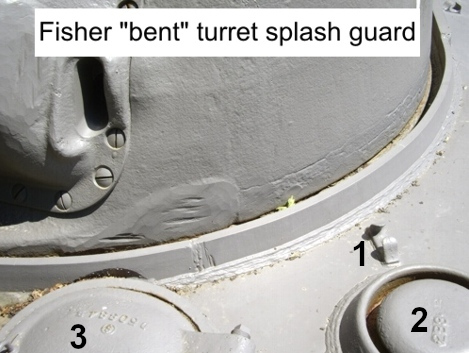
The welded hull Sherman was designed with the idea that the bullet splash guard sections around the turret would be castings, and indeed this was the case to the end of production in 1945 with every builder but Fisher. The photo on the left shows a section of the cast turret splash. As with most castings, the section can be seen with a nomenclature part number cast into it (circled in red and inset). In the Summer of 1942, Fisher replaced the turret splash castings with sections fabricated from armor cut and bent to shape where needed as shown on the right. Some other castings commonly used on Shermans include the tow cable clamp (1), ventilator (2) and small driver's hatch (3).
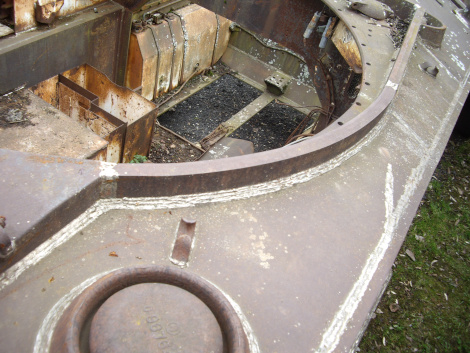
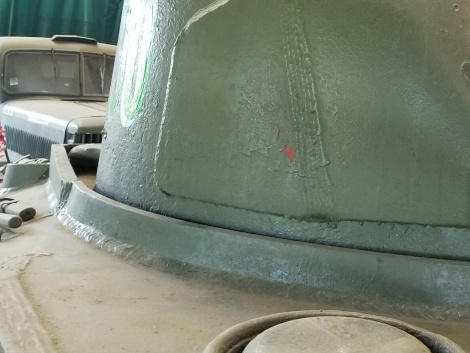
France
has the largest number of surviving Fisher M4A2s, and a few are actual
French Army combat veteran tanks on display as monuments or privately
owned. Pierre-Olivier has been visiting these as he has the time, with
the idea of taking measurements of the various fabricated components.
What he has observed suggests that the width of each fabricated turret
splash section started at 1 1/2 inches as shown on the left on Serial
Number 2495, produced in August 1942. However, he has encountered other
examples where the curved sections were only 3/4 inch wide, while the
straight sections remained at 1 1/2 inches as can be seen on SN 8873, a
January 1943 production unit thought to be a WW II veteran of the 2eme
Division Blindée. From P-O's notes, we would theorize that this change
occurred in late 1942, most likely coincident with the introduction of
the fabricated drivers' hatches and continued throughout the rest of
Fisher's production of the small hatch M4A2.
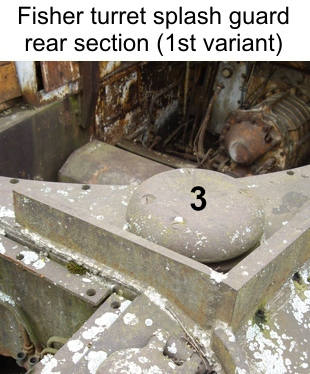





The photos above on the left show "straight" turret splash rear sections joined to the side sections. We assume that this was the "original" configuration, since it is observed on what are at present the two earliest known surviving Fisher M4A2s - Serial Numbers 2495 and 7486, both August, 1942 production. After that, starting with SN 7606 (September, 1942), surviving examples are seen with angled or bent splash sections as shown in the middle photos. This is the configuration observed on Fisher small hatch M4A2s up to the end of production in November, 1943. In fact, the use of fabricated, angled left and right turret splash sections was carried over to the Second Generation series of welded hull Shermans. For comparison, the photos on the right show the typical configuration of the cast sections used on the M4A2. Note the fire extinguisher pull housing (1), and how it is itself protected by a surround. Also seen here are some of the "official" fuel/oil/water pressed metal labels (2) used on M4A2s. Note the asymmetrical bolt pattern of the rear "mushroom" ventilator (3) typical of all welded hull Shermans, except Pressed Steel Car M4s. Oddly, this ventilator required a symmetrical bolt pattern on cast hull Shermans. One would think that a universal 5 hole casting could have been produced, but we have only seen ventilators with either symmetrical or asymmetrical bolt patterns.



The bullet splash guard in front of the engine deck doors was fabricated on the earliest M4A2s, including the Pilot. It is thought that in January, 1943, Fisher completed the transition to the cast piece that was used from the start by the other M4A2 manufacturers. Counting heads evidence is limited, but it would be our guess that most or all of Fisher's direct vision M4A2s and a few of its earliest welded hood units would have been built with the fabricated rear splash. The cast piece has been seen with Part Number C 99378 on a few surviving examples. We call it a "bullet splash," but it is described in a Fisher parts list as "Engine Compt. [Compartment] - Front Cover Casting." The piece is about 3 inches high, is removable, and was formed to accommodate 9 bolts, but we don't see any evidence that Fisher, as opposed to Pullman and ALCO, ever reamed out and used all 9 bolt slots. Like the fabricated part, at least at first, it was secured with 6 bolts as shown in the middle photo. The 6 bolt configuration appears to have been used by Fisher until around the Summer of 1943 when the number of bolts was reduced to 5. The 5 bolt configuration is what is seen on the many surviving M4A2(76)s, so would we assume it was used from the Summer of 1943 to the end of production in May, 1945.


In March, 1942 Fisher Tank ordered a "Radio Bracket B 50112" along with Front and Rear "Hoisting Eyes," Part Numbers C-95196 and C-95206, from the Ford Motor Company for an estimated cost of $73. These were described as "rough castings." It is thought that these were ordered as possible templates, but as we know, Fisher ultimately produced a fabricated Radio Bracket. On the other hand, the hoisting eyes were what we term "padded" hull lifting rings because they had rectangular bases as seen above. These begin to appear on Fisher M4A2s around the Summer of 1942. Looking at surviving examples, they do not seem to have been exact copies of the hoisting eyes provided by Ford, since they appear to have smaller bases, not to mention different part numbers - C-99457 (front) and C-99456 (rear). In any case, padded hull lifting rings were used by most of the other manufacturers of welded hull Shermans, although they transitioned to the most common or "standard" type of cast lifting rings (without the rectangular base) in early 1943. For some reason, Fisher does not appear to have transitioned to the use of the standard lifting rings until November, 1943 when the company began production of large hatch M4A2(75)s. And even then, some period photos and surviving examples show a "mix" with the standards on the front and padded ones on the rear.

As with most of the early manufacturers, Fisher started M4A2 production with the lifting rings on the turret mounted in the "high" position. This was quickly discontinued, and the low position became the de facto standard for the D50878 turret by the Summer of 1942. Pullman, which also began M4A2 production in April, 1942, appears to have switched to the low position by its third tank, which was accepted in May. The other M4A2 manufacturers, ALCO, Baldwin, and Federal Machine, didn't start production until the Fall/Winter of 1942, and the evidence suggests that all of their units were built with the low turret lifting rings. For whatever reason, Fisher continued to produce its M4A2s with the high turret lifting rings at least until February, 1943. Thus we would posit that all of their direct vision M4A2s would have had the "highs." The lifting rings were welded on to the Fishers whereas some turrets were made with the rings cast in. A couple of period photos such as the above show Fisher M4A2s with the high lifting rings, but with the stubs of the cast in rings, as if the lows were not acceptable and had been broken off. We would assume a memo was distributed to the manufacturers when the low position became preferred, but perhaps Fisher didn't get it? In any case, the photo shows USA 3063462 a December, 1942 Fisher parading through a town in Ohio in the Winter or early Spring of 1943. The Lima Tank Depot completely replaced the Toledo Tank Depot around this time, and it is thought that this series may show the transfer of AFVs from Toledo down to Lima, Ohio. Just visible on the front M4 bogie is the original half round type of track skid.

President Franklin Roosevelt rather casually called for the "Arsenal of Democracy" to make 50,000 tanks in 1942. The manufacturers scrambled to obtain the many resources and the heavy machinery necessary for for the task, but were limited by low materiel priority ratings and worker shortages, among other obstacles. Ultimately, during the 3 1/2 years of US involvement in WW II, American Industry "only" produced about 50,000 Shermans. Here we see an operation devised by Fisher engineers "whereby two machines can work on one turret simultaneously. As a means of utilizing every moment of time, the fixture holding the turret is set on a turntable so that another turret is fixed in position on one side of the table while the other is being milled. The table then revolves and work begins on the second while the first is removed and another put into position." Looking at the way the turrets are held in place, we would wonder if this procedure might have been the cause of the broken off cast in lifting rings seen in a few photos?


The
Sherman’s combat debut came with the British at the Second Battle
of El Alamein, which commenced on October 24, 1942. The story is well
known, but to recap...On June 21, Prime Minister Winston Churchill was
at the White House when he got the news of the surrender of Tobruk.
President Franklin Roosevelt asked if there was anything he could do to
help, and without hesitation, Churchill replied, "Give us as many
Sherman tanks as you can spare, and ship them to the Middle East as
quickly as possible." Soon after, Roosevelt ordered the dispatch of 300
Shermans and 100 M7 Priests. This would have been pretty much the
entire production of Shermans up to that point. The tanks were
collected up from the factories, as well as from US units that had just
begun training with them. The "5185 Opportunity" convoy sailed on July
15, 1942 with 302 Shermans and 100 Priests. The Shermans break down to
212 M4A1s and 90 M4A2s. The S.S. Fairport with 51 M4A1s and 32 Priests
on board was sunk by a U-Boat the next day. The Seatrain Texas sailed
unescorted two weeks later with replacements of 52 M4A1s and 25
Priests. The voyage took two months, and the Shermans began to arrive
in Egypt in September, 1942. Apart from these, an earlier
“regular” Lend Lease shipment of 15 M4A2s “which had
been intended to come well ahead...actually only preceded [the
emergency shipment] by a few days. The IWM photos above are dated
September, 9th. On July 15, when the convoy sailed, the only M4A2s that
were in production were made by either Fisher or Pullman. This
tank can be seen as T-74271. In another photo from this series, the USA
Number is partially visible as “305313X,” indicating that
it was made by Pullman. Note the “low” position of the
turret lifting rings. As mentioned previously Fisher
continued with the “high” lifting rings into early
1943. From that we “interpolate” that any of the
105 M4A2s in theater at the time, and seen with “high”
lifting rings would have been Fishers, and any with the
“lows” would have been Pullmans. Available period
photos suggest that Pullman M4A2s were far more numerous in
the emergency shipment, but some Fishers were sent. In a
Defect Report from Cairo dated 17 September 1942, US Army Col. E.S.
Gruver reported the Registration Numbers of 4 Fishers - USA 3020878,
3020884, 3020886 and 3020894, all of which would have been accepted in
July, 1942. The British War Department Numbers of the first 105
M4A2s all appear to have been in the T-742XX and T-743XX
range, but unlike the US Serial and Registration Numbers, these
tell us nothing about the builder or month of production of a
Sherman. IWM E16599 and E16603.
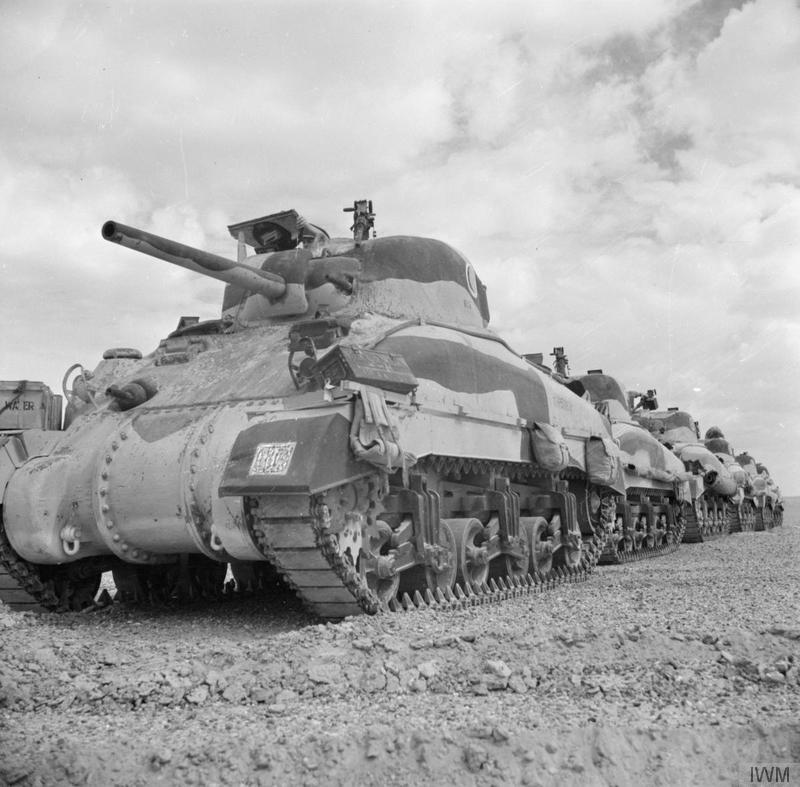
Since more than twice as many M4A1s were sent with the special shipment, they got most of the photographic “publicity.” For instance, the crews and M4A1s of C Squadron, 9th Queen’s Royal Lancers, 2nd Armoured Brigade, 1st Armoured Division were extensively photographed "in action" on October 16, 1942. It might be said that this series has become iconic, as any account of the Second Battle of El Alamein, will generally include one or more of these photos. However, the M4A2s also fought in the campaign from the start. The various “Tank State” documents record a total of 318 Shermans in the Middle East at the beginning of the battle. Unfortunately, these and the unit diaries don’t break down petrol versus diesel Shermans, so we have tried to seek out clues where possible. For instance, on September 4th, 1942, Eighth Army Headquarters directed that the 1st and 8th Armoured Divisions, along with the 9th Armoured Brigade, would receive the “Swallows.” As they were processed for issue in September, the 1st AD and 9th AB were assigned 94 and 46 petrol Shermans respectively. The first 64 diesels processed were ordered to the 8th AD, along with 30 petrols, which would be “replaced by Diesels as and when available.” From this we interpolate that, leading up to the start of the battle, the 8th AD, and more specifically, the 24th Armoured Brigade, was chosen to receive all of the available diesels. Due to manpower and materiel shortages, the 8th AD was essentially disbanded before the start of the battle, and the 24th Armoured Brigade, made up of the 41st, 45th and 47th Royal Tank Regiments, was transferred to the 10th Armoured Division on October 12th. IWM E 18377.

The WD Numbers reported for the battle in their respective War Diaries suggest that enough M4A2s to fully equip two Squadrons were issued to both the 41st and 47th Battalions of the Royal Tank Regiment, while the 45th RTR appears to have been issued M4A1s. Each of the Battalions began the battle with 3 Squadrons (A, B and C), two with Shermans, and one with Crusaders and each Squadron would have been composed of 14 tanks, assuming full availability. Unfortunately, the Shermans are not listed in the diary as “petrol” or “diesel,” but we interpolate from our counting heads research that the WD numbers in the T-74213 to T-74317 range were M4A2s. From this we take it that the 41st and 47th RTRs began the battle with only diesel Shermans. The WD Numbers listed in the diary for the Shermans of the 24th Armoured Brigade Headquarters (T-74233, T-74250, T-74266 and T-74287) indicate M4A2s, and we believe that Dover shown above, was one of these. The day before the battle, the units of the Brigade moved into their starting positions, “and tanks [were] immediately camouflaged as lorries,” as evidenced by the sunshield in place. Dover is in the process of being “teed up” with supplies, and we would observe that this tank has the additional cable clamps on the rear engine deck, and they appear to be preventing the various crates from lying flat. The dual muffler and exhaust system is partly visible here. We would have expected to see the sheet metal exhaust deflector mounted in front of (and obscuring) the mufflers, but it is notably absent in this and the few other rear shots of the Alamein M4A2s. The “71 on a square” painted on the rear sand shield identifies "Dover" as belonging to an Armoured Brigade HQ (BHQ), while another Sherman in this photo series (“Ports’th,” IWM E 18460) shows the formation marking confirming the brigade as the 24th Armoured Brigade. IWM E 18463.

The
first phase of El Alamein offensive was codenamed “Operation
Lightfoot.” In brief, the plan was for the infantry in the northern
sector of the line to attack and overwhelm the Axis’ forward positions.
Sappers would then clear two corridors through the minefields permitting
the armor to break through. “No battle plan ever survives first contact
with the enemy,” and the leading armor units, including the 8th and
24th Armoured Brigades, found that the gaps in the minefields had not
been cleared. Thus their progress was stalled, and limited to
“bridgeheads” where they faced extremely strong defenses. British
armored units took a tremendous pounding, but thanks in part to the 75
mm guns of the many M3 and M4 Mediums deployed, they gave nearly as good
as they got in a battle of attrition that the Axis forces simply could
not withstand. The
War Diaries of the 41st, 45th and 47th Battalions of the Royal Tank
Regiment state that they suffered their first tank casualties on October
25, 1942, the day after they were committed. An “Account of Operations
19th to the 29th October 1942,” written by Lt. Colonel J B Whitehead,
Commanding Officer of the 41st RTR reports, “Just before sunset about
forty German Mark III and IV tanks attacked across the flank of 41 RTR.
These were hotly engaged and several were soon in flames. Throughout the
day our tanks were subjected to heavy artillery shelling from 105mm
guns, which were numerous on our front and our first tank, 'Cocky', was
knocked-out.” The
well known photo above shows Cocky KO'd beyond recovery during the
Battle of Honey Hill in mid December, 1942. Although the tank still had
the large name across the rear, seen on a number of the M4A2s of the
24th Armoured Brigade, at that time she was serving with the Royal Scots Greys, 4th Armoured Brigade. The
WD Number can be read as T-74307, and that number is reported in a
November 1942 24th AB Tank Casualty State as with the 41 RTR, "Damaged
in battle, recovered and evacuated." Thus
it would appear that Cocky was repaired and passed on to the Greys
after the 24th AB was disbanded at the end of October, 1942. We would
assume that Cocky was one of the few Fisher built M4A2s that fought at
Alamein by virtue of the "high" turret lifting rings that can be seen in
the photo. IWM E 20514.


The 24th Armoured Brigade reportedly started the battle with 93 "Swallows." Counting heads suggests that a little more than 60 of them in the 41st and 47th RTRs, along with 24th AB Headquarters were M4A2s or Sherman IIIs. The Brigade was "used up" after 5 days in combat. Towards the end, the 41st RTR "could muster only eight," the 45th nine, and the 47th five running Shermans. The Brigade was withdrawn from the front "for a rest and refit" on October 29th. In fact, this was the unit's first and last battle. On the 30th, it's remaining Shermans and Crusaders were "handed over to Queen's Bays, 9 Lancers, and 10 Hussars" of the 2nd Armoured Brigade, 1st Armoured Division. The photos above were taken on November 10th by US Army Major Paul Wickens as part of a Military Intelligence Report "illustrating battle damage encurred (sic) by American tanks during the recent Alamein Offensive." Wickens examined about a dozen M4A1s as well as 2 M4A2s. "Many...were found about 9 miles South of the Rahman Mosque in the exact positions in which they were knocked out." Others, such as the M4A2 on the left had been removed to the "Rahman Collecting Point." The Major was an Ordnance officer, and noted that the "3 50 mm hits on turret" were not penetrations, whereas the hit on the left front sponson was. We see no obvious clues that could identify the unit, or if this was a Pullman or Fisher. It can be seen to have a 1-piece differential housing. Wickens made no comments about the M4A2 seen on the right, which appears to have been photo'd where it was KO'd. We would guess that this example was built by Fisher, as the turret splash appears to have the sharp angle (arrow) typical of the fabrications used by them. The pressed metal road wheels (1) are not commonly seen on the Alamein Shermans. The WD Number is not entirely readable, but appears to be in the T-7430X range. We don't believe that the units of the 24th Armoured Brigade ever got as far as the Rahman track, although these two may have been former 24th AB M4A2s, perhaps provided to one of the units of the 2nd Armoured Brigade as replacements?

The IWM photo above is captioned "A tank crew during a moment of relaxation in a tank battle," and is dated "29.10.42" [Oct. 29, 1942]. Sometimes the wording of the official captions can be misleading, and sometimes the dates are incorrect. John Taylor Firth, author of a history of the 47th Royal Tank Regiment, has concluded that this photo "was actually taken around the 21st October," that is, 3 days before the start of the Second Battle of El Alamein. The cartoon figure of "Capt. Reilly-Ffoul" no doubt caught the photographer's eye. An article, "From Oldham to Alamein," by Ian Hudson, that appeared in the Autumn 2020 issue of "Tracklink" identifies the crew as members of Five Troop, B Squadron, 47th RTR, and the tank as "Blighty." The piece is essentially a tribute to the young man seen in the lower right - Trooper Frederick Keates, the "wireless operator and gun loader." The 3 Shermans of Five Troop were reportedly KO'd as they advanced south of Kidney Ridge on October 27, 1942. A round penetrated the turret, killing young Fred, and wounding the Commander, Lt. Bob Hiseman (with arms akimbo in the photo), and the gunner Trooper Mackay (standing above Fred). Note the trailing return roller arm just visible on the center bogie. "Blighty" is proof that at least one of the "Alamein" M4A2s was equipped with M4 bogies. Indeed, Ian Hudson's article includes a snapshot of Blighty taken a month after the battle at the location where it was KO'd. The tank can be seen as T-74285, and has direct vision and a 1-piece differential housing, as well as the fabricated antenna bracket and turret splash typical of Fisher M4A2s. IWM E 18696.

After
their victory at El Alamein, the 8th Army pursued the retreating Afrika
Korps into Libya. The photo above shows "RIO" at a former Axis workshop
in Benghazi in late January, 1943. The "big name across the back"
suggests that RIO started the campaign as the Regimental Intelligence Officer's
tank of the Regimental Headquarters of the 41st RTR, 24th Armoured
Brigade. The tank was passed onto to another unit when the 24th AB was
disbanded, and continued to serve into 1943 until it required "3rd Line"
maintenance. RIO can be seen with in theater applied sand shields, and
"high" turret lifting rings. The British
expressed disappointment that no further shipments of Shermans would be
available to the Middle East until the end of 1942. A Tank State
document for early January, 1943 has it that there were 136
"M4A1/M4A2...Serviceable with 8th Army." The doc may provide a clue
about the next shipment to the M.E when it records that an additional 65
had "arrived since 6 Jan," and that 105 were in transit. There is also
the note that 1237 "M4A1/M4A2" and 185 M4A4 had been allocated to the
M.E. up to 31.12.42. However, 241 of the "M4A1/M4A2" had been diverted,
and would go the British 1st Army (6th Armoured Division) which had
landed in Northwest Africa as part of Operation Torch, and was then in
Tunisia. In fact, after the "special shipment" which included 264 M4A1s,
all of the British Lend Lease allocations in 1942 were of M4A2s (1111)
or M4A4s (939) with the exception of one M4A3 sent to the UK for
evaluation. Thus we would conclude that all further allocations in the
"M4A1/M4A2" category would have been M4A2s. The British found the M4A2
to be greatly superior to the M4A1, noting that it had more power and
got better fuel mileage. Indeed there were no further allocations
of 75mm Radial Shermans (M4 and M4A1) to the British until July 1943.
These came in lieu of M4A2s, as available stocks went to the Soviets.


We have seen that a few of the "emergency shipment" Shermans had advanced features such as 1-piece differential housings and M4 bogies. However, there is no evidence to date that any had the later, non direct vision drivers' hoods. Direct vision was found to be a ballistic weak point, and the Ordnance Department ordered it eliminated from welded hull Shermans on August 13, 1942. Of course, some lead time was needed to implement the change, which in all cases but Fisher, involved the introduction of elongated castings with auxiliary periscopes replacing DV. Fisher Tank designed fabricated drivers' hoods as shown above, and current evidence suggests that they were exclusive to Fisher M4A2s.At present, our best guess is that Fisher began the transition to the fabricated drivers' hoods in November 1942. Although we have encountered a few surviving examples of fabricated "large" or Second Generation drivers' hatches, to date we have not come across any fabricated small hatches, so we would assume that all of the the drivers' hatches used by Fisher were the standard D50884 A and B castings as seen in these photos.


Fisher and most of the other manufacturers used what are informally referred to as "narrow" drivers' hoods on their small hatch Shermans. Whether cast or fabricated, the hoods were about 18 1/2 inches wide, and the photo on the left shows how they were welded into the glacis. Only Ford & Chrysler used "wide" drivers' hood castings on their M4A3s and M4A4s respectively. The castings included not only the drivers' hoods but inside armor sections which met in the center (arrow) and formed part of the glacis as shown on the right.


The cast drivers' hoods, both narrow and wide, were integrated into the front turret splash configuration. On the other hand, the Fisher fabricated hoods were assembled separate and apart from the fabricated turret splash as seen in the Fisher Tank Welding Operation Instructions diagram on the left. The space between the D52575X and Y hood assemblies and the turret splash is somewhat exaggerated in the diagram, and the photo on the right shows the actual proximity of these components. Note how a small indent (circled) was machined into the turret splash at the point where it came closest to the driver's hood assembly. The diagram is also a bit misleading about the thickness of the front armor plate (1) of the driver's hood assembly. It can be seen to taper such that it is at least twice as thick at the bottom as the top.
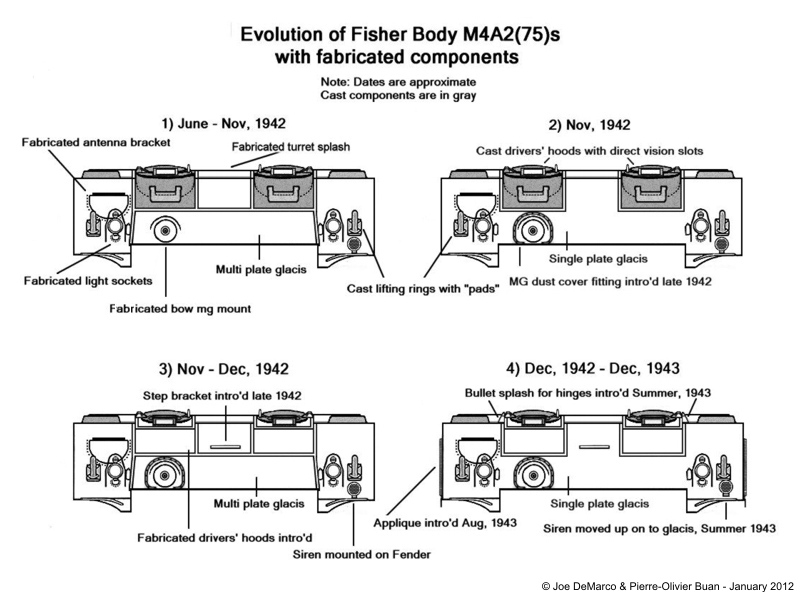
Unless the Government mandated an immediate change "without obsolescence," there were transition periods where older parts were used up, even as new and improved replacement parts were introduced into production. Thus, one might see a Sherman with direct vision that was made AFTER one with elongated drivers' hoods. The chart above shows the evolution of the Fisher M4A2 glacis with fabricated components, including the transition from the multi-part to a simpler and more ballistically sound single plate glacis.

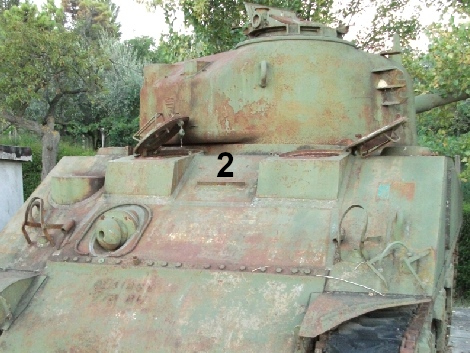
The authors have yet to encounter any surviving M4A2s with transitional pattern 2, but it can be seen above left on this USMC Sherman, which was most likely one of the first M4A2s the Marines received at Camp Elliot, California in early 1943. Transitional pattern 3 is also rare, but Pierre-Olivier examined an example in Chieti, Italy, and recorded the Serial Number as 8514, indicating December, 1942 acceptance. Note that the Marine Sherman can be seen with the fitting (1) for the bow machine gun dust cover, but not the little step (2) between the drivers' hoods, which is on the Chieti. These were some of the first of the many modifications that became standard items on the Sherman series. They appear to have been introduced into production at Fisher in late 1942. Depots were also mandated to install them to tanks received without as supplies became available in early 1943. We would observe that these items would not be seen on the "emergency" Shermans shipped to Egypt in July, 1942, but they do appear on many of the M4A2s of the follow up shipments that began arriving in early 1943.

Another
modification introduced in late 1942, that became standard on the
Sherman series was the the "Driver's hatch hood and windshield." This is
described in the M4A2 Technical Manual dated January 13, 1943, "A removable folding hood, with
safety glass windshield is provided for protection of the driver. It
may be attached, by means of special fittings, to cover the open hatch
over the driver's seat. The windshield has an electric wiper and an
electric defroster, which receive their current through a flexible cable
that can be plugged into an outlet on the instrument panel." The Manual
does not include an illustration, so we've used one from the M4A4 TM on
the left above. This shows the bow machine gun dust cover snapped onto
its fitting as well. The right side photo shows the "special fittings"
that held the hood in place. These little catches can be seen on many
surviving Shermans of all types. When not in use, the hood was stored on a shelf above the transmission.

The crews of early production Shermans were subject to injury from falling hatches. Positive hatch lock mechanisms with equilibrator springs were reported to have been introduced at the Grand Blanc Tank Arsenal in late June 1943. One document has it as at Serial Number 26735 for the locks and 26742 for the springs. Of course, we don't have enough counting heads data to confirm these exact SNs but would observe that this was somewhat late compared to other manufacturers who began installing this important safety modification months earlier. The locking mechanisms (1 and 2) secured the hatches when opened. The springs (3) were provided to assist the drivers in opening and closing the heavy hatches. Starting around the Fall of 1943, modification kits were provided to Tank Depots for retrofit to Shermans that lacked this item. Furthermore, 1000 kits were shipped to the UK in November 1943 as an "Urgent" modification to be applied where missing to the 1397 "M4 and M4A1 in US Pool" there before D-Day. Note how the fabricated hinge knuckles (4) were not rounded as was the case with cast drivers' hoods but angled. Also of interest is the little bullet splash (5) protecting the drivers' hood hinge knuckles. These appear to have been introduced at Fisher in May 1943. An ALCO drawing labels them "Guard, Hinge" and shows that they were welded assemblies made from "1/2 Armor Plate" with Part Number 8673287 for the right-side piece and 8673288 for the left. At present, aside from Fisher M4A2s, the "hinge guards" have only been seen on ALCO M4s produced starting in April 1943. The reason these parts do not seem to have been used by any other manufacturers provides a good "Sherman mystery." Should any readers have any documentation about the hinge guards, we would be pleased to see it.


Eagled eyed readers might have noticed that the forward cable clamp seen in the previous photo of the historic "Valois," Serial Number 26875, a French monument M4A2 produced in July, 1943 is not in the "usual" location, but instead is welded on next to the driver's hatch. The "usual" location is shown circled above on the left on another French monument, the historic "Massaoua," Serial Number 26830, also July, 1943 production. We don't have a large enough base for counting heads, but can observe that the cable clamp is seen next to the driver's hood on another surviving French M4A2, SN 26852, as well as SN 26908, which is currently sitting in a field on the island of Guadalcanal. Both are July production. Period photos of the French M4A2s "Austerlitz" (above right), "Argonne," "Himeimat," and a few others, show the cable clamp located next to the driver's hood as well. This small sample seems to suggest that Fisher moved the cable clamp next to the driver's hood starting in July, 1943, and we will try to investigate further in the future.
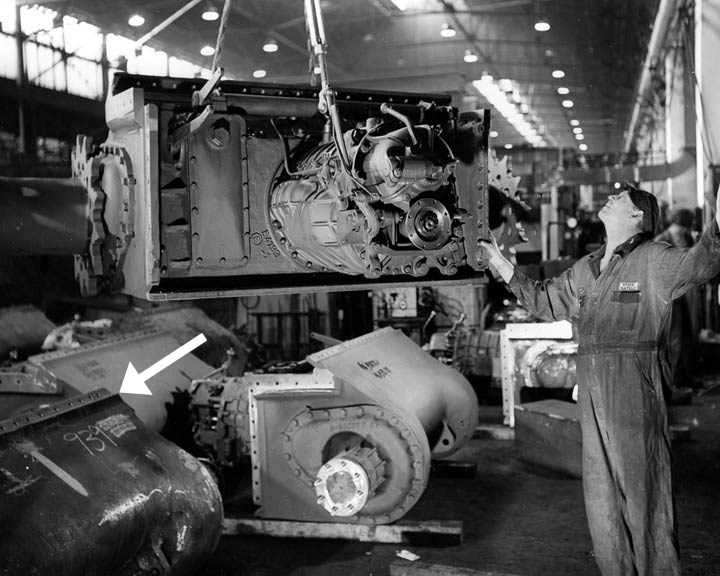
Buick converted a pre-war "automobile shipping warehouse" in the Detroit area to a factory that produced M4 (and later M26) power trains. Ultimately the company manufactured 19,428 P.T.s during WW II. From the beginning, their M4 power trains were constructed with the recently designed one-piece E4186 differential housing. From the standpoints of ease of production and ballistic protection, this was a great improvement over the three-piece differential of the M3 Medium, which was carried over to the M4 series design. The Ordnance Department wanted the superior one-piece final drive housing on all Shermans, but some manufacturers, most notably Chrysler, stated that they could not make the change from the 3-piece to the 1-piece without creating a serious disruption in tank production. In the Summer of 1942, continuous tank production was paramount, and ultimately, the complete transition to 1-piece differentials was not achieved until September of 1943. An Ordnance document states that the point of introduction at Fisher Tank was April 30, 1942, during the first month of M4A2 production. However, counting heads suggests that Fisher did not fully complete the transition to Buick power trains with 1-piece differentials until the end of June. After that, the evidence is that all Fisher Shermans and Tank Destroyers were produced with 1-piece differentials. The photo above shows power train production at Buick in 1942. While some early E4186 differential housing castings were "flat" at the top, Buick diffs were designed from the start with a protective "lip" (arrow).


Compared to the M4A4, the other primary Lend Lease Sherman type, there are relatively few surviving M4A2(75)s to study. Of those, about 20 are Fishers. The examination of the Fishers suggests that in the early days, Buick had two primary suppliers of E4186 castings, Union Steel (left) and American Steel Foundry-Granite City (right). Both sets of casting marks are rather prominent, and are positioned on the upper left of the differential housing as you look at it. We would note however, that in the study of US armor, left and right are determined as if someone were sitting in the driver's seat. So from that perspective, the casting marks would be considered to be on the upper right. Casting marks generally include the Part Number of the piece (1), the maker's logo (2) and the Part Serial Number (3). The Union Steel example can be seen to have Part Serial Number 1061. We can only conclude that the additional mark, "BU," (4) stands for Buick. The serial number of the ASF-G diff is A2637, with the 2 prefix possibly indicating a part revision number. If any readers can document the meaning of "LO" seen on this and many other ASF castings, we would be pleased to have your report.


Since Fisher pioneered the use of fabricated parts, they were tasked with designing a "combination welded and cast differential and final drive assembly." Two prototypes were constructed and installed on Fisher M4A2s, SN 2428 (July, 1942) along with SN 2493 (August, 1942), which is shown above on the left at Aberdeen Proving Ground on September 1, 1942. These were intended to be tested at APG, with the idea that the welded/cast design, if acceptable, might save some foundry casting capacity, which was stretched to the limit at the time. As it was, only 2493 was evaluated, and the welded/cast differential project was shelved since it offered no significant benefit over the standard cast assembly. Oddly, SN 2428 never made it to APG. The tank, with its expensive prototype differential, was reported "shipped by error August 20, 1942 to the Russians" by Army Field Service officials at the Toledo Tank Depot. From the AFS docs, we interpolate that the very first lot of 26 Soviet Lend Lease M4A2s was processed at TTD, sailed on the SS John Walker a week or two later, and arrived in the USSR in November. We would conclude that the photo on the right, taken at the Fisher Tank Arsenal in July, shows SN 2428 since a comparison of the casting marks on the gun shield (circled) shows an obvious difference with those on SN 2493. Of interest is that the M4A2 on the far left "still" has a 3-piece differential housing. An M3 type bogie is just visible in the shot, as is a fabricated antenna bracket. What we assume was a fabricated bow machine gun socket was airbrushed out for some reason.

Period photos show some Fisher small hatch M4A2s without the prominent Union Steel or ASF casting marks on the face of the differential housing. As M4A2 production ramped up, and M10 production commenced at Fisher in September, 1942, Scullin Steel was added as another supplier of E4186 castings. We have yet to find one of these on a direct vision Fisher M4A2, but the sample, as mentioned, is admittedly small. Here we see Scullin's "SS in an oval" logo on the E4186 casting of M4A2 Serial Number 9008, which would have been accepted in February, 1943. Note that the casting info is "hidden" on the underside of the differential housing as became common practice. This particular casting is serial number 1140, and it can be seen with the "CTC" logo which we believe indicates that it was intended to be supplied to the Caterpillar Tractor Company, not Buick, as one would expect. We find no evidence that Caterpillar provided "transmissions" to Fisher Tank after the first few months of production. Ordnance documents state that General Motors, Ford and Chrysler produced their "own" transmissions, while Caterpillar, Mack and Iowa manufactured them for the smaller "railroad" builders. In any case, we don't assume that surviving Shermans necessarily have their original diffs and turrets and such, so this may be a replacement. However, Pierre-Olivier believes that the original tank serial number is partially visible on the front towing lugs, and hopes to revisit and try to get an accurate read of it. Unfortunately there is very little possibility of entering the tank to see if it might still have a Power Train plate identifying the manufacturer as either Caterpillar or Buick/GM.

In the Spring of 1943, an improved transmission with double anchor brakes, and a new differential housing with improved ballistic properties were designed for the Sherman series. This combination was mandated to be installed on all US built Shermans starting in September, 1943. The "sharp nosed" E8543 differential housing is shown above on Serial Number 26830, a July, 1943 production M4A2 combat casualty on display as a monument in Ecouché, France. Indeed, we believe that Fisher was an early adopter of the new power train components, and that they completed the transition by the end of July 1943. This can be confirmed as the original differential housing of this tank, since the serial number stamped on the diff matches the serial number stamped on the dataplate. The housing can be seen with double towing lugs (1) on each side, and cast in steps (2). The doubled lugs held the pins of the newly introduced quick release towing shackles, and the steps were provided for the convenience of the crew. However the cast in steps interfered with the operation of the new shackles, and were soon replaced with metal strip steps. As shown in the inset, this particular differential housing was cast by Scullin Steel, and can be seen with the "BU" marking and a low part serial number of 84.

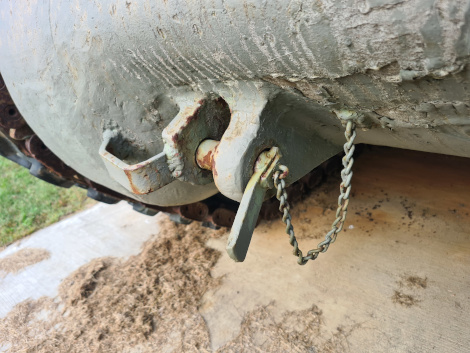
Above
we show photos of the new Quick Release Towing Shackles on an
M4A2(76), since we couldn't find a surviving Fisher M4A2(75) that still
has them intact. Fisher reportedly introduced the "front towing shackles
with handle" on 14 July 14, 1943, at SN 26787. This simple pin and
locking handle arrangement required double towing lugs, so went hand in
hand with the introduction of the E8543 differential housing. The Quick
Release Shackles were wanted on the rear as well, but this modification
was mostly "not to be incorporated" on First Generation Shermans since a
second rear tow lug would be needed, and most of these models were
being discontinued. At Fisher, it is thought that double tow lugs on
the rear were introduced in late 1943, possibly at the transition from
the small hatch to the large hatch M4A2(75).


The few surviving Fisher M4A2(75)s are noted with Continental-Wheeling, General Steel or Pittsburgh Steel Foundry turrets. These appear to have been Fisher's primary sources at least through 1944. For instance, in February 1943, it was reported that the company was supplied with 50 turrets from Continental-Wheeling, 225 from General Steel-Eddystone, and 58 from Pittsburgh Steel Foundry. Of these 3 brands, only the Continental turret castings are noted with the 3 "bumps" (circled - sometimes referred to as "set up pads") as shown on the left above. American Steel Foundry turrets, commonly seen on M4A4s, appear to have been the only other turrets cast with the bumps/set up pads. The photo on the right shows the casting marks on the turret bustle of Fisher M4A2 SN 7606, which would have been accepted in September, 1942. The turret serial number 169 seems appropriately low, leading us to judge that it is the original turret of this tank. Continental casting marks are often seen to include "HT" which we believe stands for "Heat Treatment." Unlike serial numbers, HT numbers were not exclusive to a single casting. Ordnance documents suggest that as many as 6 turrets could be heat treated at the same time, with all 6 sharing the same Heat Number. HT Numbers were not cast, but were stamped into the raised pad, seen here between "HT" and the "W in a C" Continental-Wheeling logo.


American Steel Foundry, Continental, and General Steel were the major producers of turrets, with each having a monthly output at full capacity of about 500 units. Consequently, these are the most common turret brands seen on surviving Shermans. Aside from Fisher, General Steel provided turrets primarily to Ford. However, ALCO, Pressed Steel Car and Pullman received allotments as well. Additionally, best evidence indicates that all 188 of the M4A1 Grizzlies built by Montreal Locomotive were equipped with General Steel no pistol port D50878 turrets. The photo above shows a General Steel turret casting on M4A2 SN 8887 (Jan. 1943 production) on display in Arromanches, France. This tank is kind of a mystery. It has the "serial number in a box" stamping on the glacis, and an AMX rebuild tag (insets), both of which suggest that 8887 was in service with the post war French Army. However, we are not convinced that this unit was one of the 382 M4A2(75)s received by the French as Lend Lease during WW II. Perhaps the French got it from the British? In any case, the turret is an example of an Eddystone product with the casting information located under the pistol port as shown on the right. The distinctive General Steel "G in a Shield" logo is present, but is somewhat distorted. The turret serial number is 2378, with the "E" suffix indicating the Eddystone foundry in Pennsylvania. The location of the casting data in this area produced a sort of sharp undercut at the bottom of the pistol port opening. Counting heads suggest that the plant discontinued the "under the turret" configuration in April, 1943. At that point, the casting information was relocated to the roof of the turret with the General Steel logo displayed prominently on the turret bustle. This appears to have been the configuration used from the start on turrets cast at General Steel's Commonwealth plant in Granite City, Illinois.


Pittsburgh Steel Foundry (PSF) turrets are rarely encountered on surviving Shermans. Above left shows a heavily updated example on Fisher M4A2 SN 7975 which would have been accepted in November 1942. The casting information is located on the turret bustle as shown on the right. We have tried to "fill in the blanks" since some of the numbers and letters are obscured. PSF markings very helpfully included the date the turret was cast. However, in this case range damage has rendered it only partially readable as "1?-42" with the question mark assumed to be a 0, 1 or 2, making the casting date "late 1942." What we take to be the turret serial number can be seen as "103." At present, the lowest such number we have recorded from a PSF turret is 81, and the date on that example is clearly visible as "11-42". Consequently, we might assume that 103 was produced in November or December 1942. PSF was located in Glassport, Pa., and was qualified to produce turrets at the rate of 330 per month. However, due to cutbacks in the Army Supply Program, the company's actual output appears to have averaged a little over 100 turrets per month. We work under the assumption that, in general, the turret serial number reflects the number of castings produced. Thus, we assume that the surviving no pistol port, PSF D50878 turret, serial number 1047, would have been their 1047th, and we can observe that it was not produced until June 1943. Chrysler, Fisher and Ford are said to have machined the turrets that they received, and one thing we have noticed is that Fisher alone seems to have assembled the secondary antenna bracket from several pieces welded together as seen on our subject (arrow). This would lead us to think that if this PSF turret is not original to SN 7975, it would have been original to another Fisher. The lifting rings on turret 103 are in the low position and are cast in as opposed to welded on.


These
Signal Corps photos feature Lt. Yu-Nan-Chang in command of "Blushing
Bride," one of the Demonstration Regiment's early Fisher M4A2s. The absence of the gunner's blade sight suggests that this
unit was produced in May or perhaps June, 1942. The tank is seen with
the original M34 Gun Mount where the lifting rings on the gun shield
were welded on very close to the rotor shield (arrow). Some
of these "close mounted" lifting rings got damaged and bent inward in
service, which caused them to foul against the rotor shield, disabling
the elevation of the gun. Consequently, the lifting rings were directed to
be mounted further outboard, but there is some evidence that Fisher
stayed with the original configuration into late 1942.

The photo above, dated 6 October, 1942, is part of a series showing M4A2 Shermans of the 34th Armored Regiment, 5th Armored Division at the Desert Training Center in California. We take Tank H-5 to be Fisher built based on the fabricated antenna and bow machine gun sockets. We take Tank I-13 to be a Pullman based on the small glacis casting that included the bow MG socket (1). Both of these tanks are seen in other photos with M4 bogies, and we would speculate that they would have been produced July, 1942 or after, but, of course, before October. Note that H-5 "still" has the original M34 Gun Mount configuration, while I-13 has the revision with the gun shield lifting rings positioned outboard. The gun mount is further updated with the protective side extensions on the rotor shield (2), a change which carried over to the M34A1 Gun Mount. Neither tank has the little step in the middle of the glacis, which seems to have made its first appearance on the Sherman around December, 1942. Only H-5 has the bow MG dust cover fitting. Indeed, this is the earliest dated photo we know that shows this fitting on a Sherman.


The aperture on the gun shield for the coaxial machine gun was more or less an unprotected "opening," and in late 1942, a cast armor shield was provided for Shermans equipped with the M34 gun mount. It was included as On Vehicle Materiel on tanks that were scheduled for shipment to combat zones. Most of the reinforcement Shermans that flooded into Northwest Africa in the first half of 1943 were "still" equipped with the M34 gun mount, and many of these appear to have been provided with the MG shield. Period photos suggest that Shermans with "shielded" M34 gun mounts continued to serve in Italy right up to the end of the the war. After Operation Dragoon in August, 1944, a few are also seen in the southern part of the European Theater on US and French Shermans of the 6th Army Group. A close up of the casting is shown in the left side photo on "Bradford," a Fisher M4A2 with welded drivers' hoods. The National Army Museum caption for this series of photos reads in part, "Sherman tanks of 3rd County of London Yeomanry at Catania harbour, 1943...British tanks and their crews wait to be loaded onto ships prior to the Allied invasion of Italy in September 1943. The 3rd County of London Yeomanry had landed in Sicily on 10 July as part of 4th Armoured Brigade, having previously served in North Africa and the Middle East." In these photos, "Bradford" can be seen with the later M34 configuration of "outboard" gun shield lifting rings, and side extensions on the rotor shield. The lifting rings appear to be part of the gun shield casting, not welded on. Such castings have also been seen on some surviving Fisher M4A2s (inset).

The original periscope gun sight was found unsatisfactory, so the Ordnance Department designed a new gun mount that incorporated a direct sight telescope. A mock up was photographed at APG on June 22, 1942. The sides of the rotor shield were extended to protect the telescope (1) and the .30 caliber coaxial machine gun (2). Designated "Combination Gun Mount, M34A1," the new design was released for production on October 16, 1942. Most changes to the Sherman were introduced "with obsolescence." This permitted the manufacturer to use up supplies of the old parts, even as the new parts were introduced into production. The addition of the direct sight telescope was deemed so important that the M34A1 was initially released "without obsolescence," with a cut off date of January 15, 1943. The manufacturers could not obtain all of the parts necessary to meet such a rigorous deadline, and ultimately, the M34A1 did not completely replace the M34 gun mount in Sherman production until the end of April, 1943. Government records have it that the M34A1 Gun Mount was introduced at Fisher Tank on 30 March, 1943.
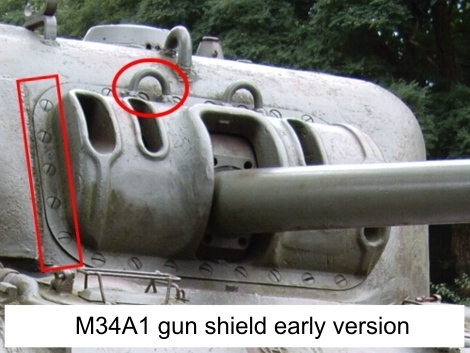


The use of the early type M34A1 Gun Mount at Fisher appears to have been to limited to M4A2s produced in April 1943, and perhaps a few in May. In all, we'd guess it would have been about 200-250 units. We don't know of any surviving Fishers with the early type M34A1 Gun Mount, but they are present in a number of period photos of welded hoods M4A2s in Commonwealth service. There were no Lend Lease allocations to the Soviets in 1943 until July. On the other hand, the British were allocated over 2200 M4A2s during the span from March thru May, 1943. This would lead us to think that most of the Fisher M4A2s with the early type M34A1 Gun Mount would have gone to the British. The IWM photo above shows what is obviously a Fisher M4A2 with the early version of the M34A1 gun mount. The caption has it that the scene was filmed 13 May, 1944 as tanks of the "6th Armd. Div. nr. Cassino" prepare to cross the River Gari under cover of a smoke screen. Note that this tank was not factory installed with the drivers' positive hatch locks (June, 1943) or the bullet splash for the drivers' hood hinge knuckles (ca. May). However, it may have the "Turret Door Locks" reported to have been factory installed at Fisher starting on 5 May, 1943 at SN 26424. It can be seen that the headlamp plug holders are "still" mounted in the original orientation parallel to the glacis. The Federal Type 160 siren is seen here as opposed to the more commonly used Mars Signal Light siren. It is thought that Fisher repositioned the siren from the front fender up to the glacis in May, 1943. The appliqué armor on the hull side was most likely applied in a Base Workshop in the Middle East using Quick Fix Modification kits sent from the US. IWM NA 14737. IWM NA 14737.
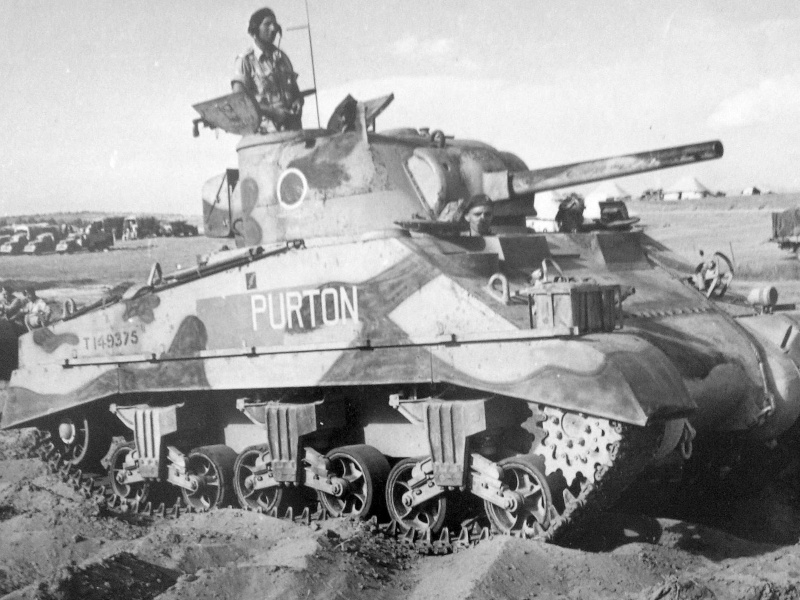
The 9th Armoured Brigade was more or less destroyed during the 2nd Battle of El Alamein. The Brigade lost 3/4 of it strength, but rather than being disbanded like the 24th Armoured Brigade mentioned earlier, it was posted to Palestine/Syria to be rebuilt. It was decided that the regiments of the brigade, the 3rd Hussars, the Royal Wiltshire Yeomanry and the Royal Warwickshire Yeomanry, would be reconstituted with Shermans exclusively, and eventually each was issued about 60 M4A2s. In October, 1943, to commemorate the 1 year anniversary of Alamein, the entire Brigade took part in a parade that was featured in edition 134 of the British newsreel "War Pictorial News." Each tank is seen with a large name painted across its sides. Most of the M4A2s shown in the newsreel and still photos are equipped with M34 gun mounts, but here we see a rare example with the early version of the M34A1. T-149375 served with C Squadron of the Royal Wiltshire Yeomanry. The Wilts' M4A2s carried names of towns and public houses ("Purton" was named after a village in the county of Wiltshire), and portraits of individual tanks and crews were sent to the folks back home as a way of keeping in touch. This has provided the researcher with exceptional documentation of the Wilts' Shermans in particular, as we have seen about 25 of these portraits. All of the tanks that appear in the photos have sand shields, the vast majority of which are the type that were factory or depot installed in the US before the introduction of the universal type in mid 1943. Note the M3 style drive sprocket. Like the other builders, Fisher started production with these. The "plain" sprockets were introduced in late 1942, and appear to have been used alongside the M3s, up until about August, 1943. At that point until the end of production, Fisher Shermans are seen exclusively with the "plains." Note that "Purton" was not installed with the "Turret Door Locks." We suspect she may have been one of the first Fisher M4A2s to have the headlamp plug holders mounted in the upright position. The triangular object just above the shovel was not factory installed, but was one of a number of items retrofitted to M4A2s that were processed for issue by British Base Workshops in the Middle East. There was one on each side, and they served as stops for the heavy engine deck doors.

The periscope covers used on Shermans started out as simple flat affairs. The covers used for the auxiliary periscopes of the drivers' hatches appear to have remained consistently "flat" to the end of production. As a matter of "Sherman minutia" we would observe that, starting in early 1943 and running at least to the end of small hatch production, Fisher appears to have received steady supplies of the "peaked" periscope covers (inset) for use in the 5 other periscopes positions. These are rarely visible except in overhead photos, but they can actually be seen on the drivers' hatches, the commander's hatch, and on the gunner's and loader's periscopes in the photo above. Standard M6 periscopes are in place on the driver's hatches. The tank appears to be in a configuration similar to "Purton" in the previous caption, with no evidence of hatch locks on the drivers' and commander's hatches, and the headlamp plug holders mounted in the upright position. One of the lifting rings on the gun shield is just visible, which would identify the gun mount as the early M34A1. Note the "Swabey Sight" affixed to the original commander's blade sight. This was designed in the Middle East, and installed on many Commonwealth Shermans there and in India starting in December, 1943. The photo is dated January, 1944, but the unit is unnamed. The crewmen can be seen to have Polish badges on their berets which would identify the Brigade as the 2nd Warszawski Armoured. The Brigade deployed to Italy in April, 1944 and had its combat debut at the Battle of Cassino in May.

About a month after the 9th Armoured Brigade parade, the M4A2 had its combat debut with the US Marines during the Battle for Tarawa, 20-23 November, 1943. Company C, of the 1st Corps Tank Battalion landed 14 Shermans on the island on D-Day. "Condor," shown above, along with "Charlie" and "Cannonball" were reportedly KO'd by Japanese 75mm Anti-Aircraft guns during the fighting at the air strip on the first day. A close examination of the original Archives print of this photo shows that Condor was USA 3035025 (outlined in red), indicating May, 1943 acceptance, with a corresponding Serial Number of 26495. From examining the available photos of Company C's Shermans on Tarawa, we suspect that all of them were built by Fisher in May, and that Condor reflects their general appearance. "Tarawa on the Web" includes a snapshot of Cuddles where they report "faintly visible is serial number, 3035021" which was probably accepted on the same day as "Condor." At any rate, Company C is reported to have shipped out of San Diego in July, 1943 with "new tanks," so they probably couldn't been made any later that June. "Condor" can be seen with the later type of M34A1 gun mount leading us to think that Fisher began this transition in May. Another transition that appears to have started in May was the relocation of the siren from the fender to the glacis. One of the "Turret Door Locks" on the commander's hatch can be seen just behind the canteens. Visible under the bow gunner's hatch is the bullet splash for the drivers' hood hinge knuckles. However, no positive hatch locks are in evidence. This tank appears to have the strips designed to hold the "interchangeable" or "universal" type sand shields. These were reported to have been introduced at Fisher Tank on 10 May, 1943 at SN 26463. Condor can be seen with the "plain" sprockets and pressed metal road wheels and idlers. The head lamp plug holders are still in the first position. It would be our guess that Fisher did not complete the transition to the upright position until June, 1943.

This
interesting photo is dated May 21, 1945 and shows a trio of USMC M4A2s
that may have been returned from overseas to Rock Island Arsenal for
inspection. If so, we regret that we did not come across an RIA report,
assuming one was made. The focus tank is listed as Serial Number 26523,
which would make it May, 1943 acceptance. The small fittings (arrows) on
the turret are similar to what can be seen in photos of Cuddles and Chicago. In
the book, "Tanks in Hell: A Marine Corps Tank Company on Tarawa," the
authors note that Cuddles, Chicago and a few others are seen with
"small support brackets" welded to the turrets and hull sides,
presumably to hold wire on which camouflage vegetation could be
hung. The upper rear hull plate of 26523 was cut out at some
point, perhaps to supply add on armor to another tank? The lower
rear hull plate does not appear to have weld scars from wading trunk
attachment strips, which may be a another clue of a Tarawa Sherman,
since they were not installed with wading trunks, and the results were
disastrous, as the majority of C Company's M4A2s were disabled by sea
water in one way or another. "Tanks in Hell" states that "All [of
C Company's] tanks were re-equipped with new steel-faced tracks to
replace the less durable rubber-faced track provided at the factory."
Judging by their ubiquity in period photos, the Marines had a
preference for T54E1 tracks (1). The [towing] "pintle, long" (2)
was reported to have been installed at Fisher starting on 13 April,
1943 at SN 16531. The perforated steel mesh (3) around the turret
basket is intact. If this tank had been retrofitted or factory
installed with the "Quick Fix" modification, the turret basket would
have been "skeletonized" by removing the mesh, which tended to restrict
the turret crew's escape in emergency situations. The M4A2 right next
to 26523 can be seen to have been retrofitted with a large housing
around the periscope on the commander's hatch. We are informed by
TIH co-author Romain Cansiere that this was "unique to C Co, 4th
Tank Battalion during the Marianas [Campaign]. Additionally, the square
to the left of the wading stack represents the old position of the
tank-infantry phone, also unique to this unit." This tank can also be
seen with an applique plate on the side of the hull. These were
added as part of the "Quick Fix" mod to protect the main gun rounds
stored on the sponsons. Inside, the sponson ammo bins were armored as
well. The "Quick Fix" was reported to have been installed at Fisher on
5 August, 1943 at SN 26920. The tanks to the right of 26523 both have
"no pistol port" turrets, which appear to have entered the production
pipeline at Fisher in July, 1943. The M4A2 on the far right can be
seen to have the armored cover cap (4) for the "Engine Oil Gauge." This
cap protected a pair of dipsticks which provided a convenient means for
the crew to check the oil levels of the engines.
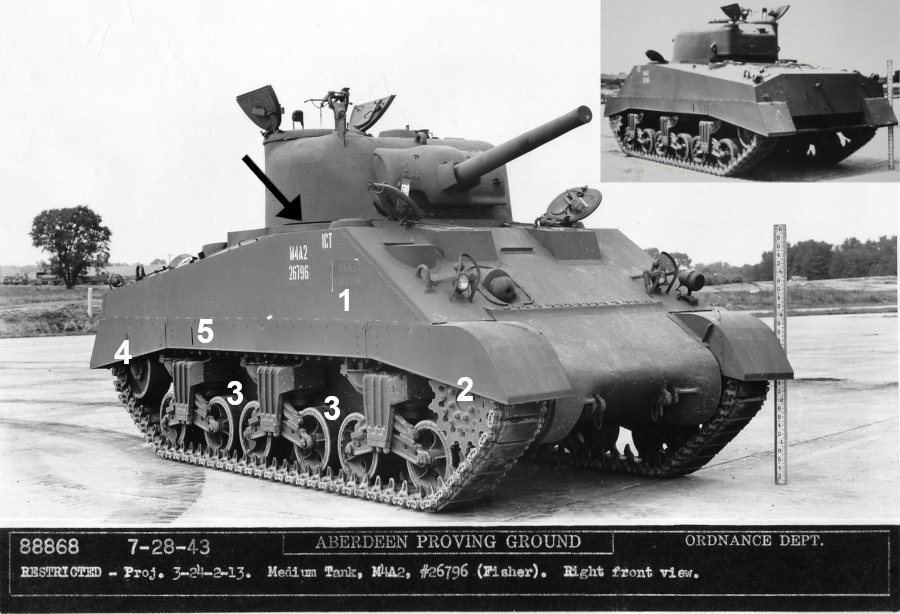
Serial Number 26796/USA 3035326 was one of the few 1943 production Fisher M4A2s that was photographed by the Ordnance Department. In this case it was the subject of an Inspection Control Test at APG in late July, the same month during which it was accepted. Starting in the Spring of 1943 through the Summer of 1944, Fisher appears to have painted the USA Number very small in blue drab on the front sides of its Shermans as seen here (1). This practice seems to have been exclusive to Fisher, and was at variance with the instructions we have seen regarding the size and location of the Registration Number. Ordnance Department tests found the original D50878 turret's pistol port to be a ballistic weak point. In addition, a couple of areas on the inside right front of the casting had been thinned to allow for the proper operation of the traversing mechanism. As the first Shermans entered combat, troops began to report that the enemy aimed for these "thin spots." In April 1943, the D50878 turret was revised to eliminate the pistol port, as well as "increase thickness of turret in area of the traversing mechanism." The revised turret castings began to enter the production pipeline at Fisher around July, 1943. The bottom of the "cast in thickened cheek" is indicated by the arrow, and the inset of the rear view shows that this General Steel turret had no pistol port. "Still" absent on this tank is the Engine Oil Gauge armored cover cap. The M3 type drive sprockets (2) seen here appear to have been used alongside the "plain sprockets" up until about August, 1943, at which point the plains are seen exclusively on Fisher Shermans. Small hatch Fisher M4A2s are seen installed with a complete set of either the welded spoke road wheels (3) or the pressed metal type. Welded spoke idler wheels carried over from the M3 Medium, and were used at the outset of Sherman production, but these gave problems, and Ordnance mandated a change to the "Disc Type" [pressed metal] idlers (4) on all Shermans with a cut off date of 1 September, 1943. Fisher reported that they made the changeover fairly early on 26 March, 1943. The interchangeable or universal type sand shields can be recognized by the vertical slit (5) in the center section. These were reported to have been introduced at Fisher in May, 1943.

Our Canadian friend, Jim Goetz has a "bucket list" goal of visiting every surviving Sherman tank in the world. He had to take a number of "trains, planes and automobiles" to get to Guadalcanal to see the M4A2 shown above. Jim reported that the Serial Number is 26908, indicating July, 1943 acceptance. Fisher appears to have introduced power trains with the "final," sharp nosed E8543 differential housings (1) during that month, and this example features towing lugs with the welded on strip steps that replaced the earlier cast in steps. The turret is General Steel Eddystone Serial Number 3722, and has what we believe is a factory installation of the thickened cheek armor (2) and a welded up pistol port (3). These two mods generally went hand in hand at factory or Tank Depot. We keep a record of surviving General Steel turrets, and the earliest welded up pistol port example we have noted so far is SN 3261E, cast 15 April, 1943. The earliest no pistol port GS turret we have recorded is 3985E which would have been 263 turrets later than 3722. Counting heads suggest that both of these were cast in May, 1943. The evidence seems to be that Marine M4A2s were not processed at US Tank Depots, but were shipped directly from the Fisher plant to a USMC facility in San Diego. The Ordnance Department was anxious to have the "Quick Fix" modification installed as soon as possible. Fisher Tank reported that they could begin doing so 10 days after they received the first supplies of the Government Free Issue kits. This change is reported to have taken place on 5 August, 1943 at Serial Number 26920. Additionally, the initial installation of the drivers' hood applique mod was reported to have been done on the same tank on the same day. We would note that SN 26908, which was made 12 units before, does not have the drivers' hood mod. It has the Quick Fix external applique (4), and a "skeletonized" turret basket, but from Jim's pix, the ammunition racks do not appear to have been armored. We suspect that, in this case, only part of the "Quick Fix" modification was installed by a USMC Ordnance unit from kits provided by the Army. The Battle of Guadalcanal, one of the most interesting campaigns of WW II, took place from August 1942 to February 1943. The Marines were equipped with a few M2A4 and M3 Light Tanks, but no Shermans. Indeed, SN 26908 had not even been built when the island was secured. Perhaps the garrison stationed there afterwards requested a range target? The name "Jezebel" is faintly visible on the right front applique plate, and we would observe that an M4A2 named "Jezebel" served with the 4th Marine Tank Battalion during the Roi-Namur Campaign in February, 1944.
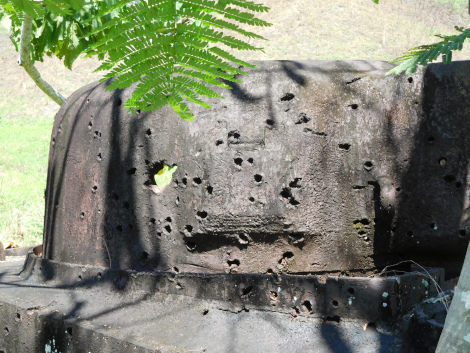

The
left side view provides a close up of the welded up pistol port. These
can be hard to discern in some period photos, but in general, the 2
hinge barrels at the top were removed from the door casting before it
was welded on. So, if there are no hinge "bumps" protruding in a
photo...The right side view shows how the pistol port (1) was welded on
from the inside. It is thought that starting in July, 1943 through the
end of production in November, most Fisher small hatch M4A2s would have
been built with no pistol port turrets, with a few welded up pistol port
turrets mixed in. Evidence suggest that the Soviets got most of these.
The interior view also shows that the turret basket was "skeletonized,"
as per the Quick Fix mod, with almost all of the steel mesh (2) removed
to provide the crew with greater means of escape. Also eliminated were
the 12 exposed ready rounds clipped to the turret basket wall in the
original design. The remaining 8 ready rounds on the turret basket floor at the foot of the loader were
encased in a bin made up of 1/4 inch armor. Only part of this bin (3)
remains intact; for instance, it would have had an armored lid, but just
the hinges are left. To our eyes, the ammunition rack (4) sitting on
the left sponson appears to be the original, unprotected design, that is
it does not show evidence of having been encased in 1/4 inch armor
plate with an access door facing the rear. Tank crews wanted to carry as
much ammunition as possible into action, and the safety restrictions of
the Quick Fix and later Wet Stowage modifications
appear to have been ignored in some cases. A Tarawa veteran mentions
one of the "lessons learned" modifications that they made to their
replacement Shermans, "To start with they had racks for ninety-seven
rounds of 75 millimeter. We modified those racks and put a hundred and
twenty-five rounds in."

This fine drawing from the January, 1943 M4A2 Technical Manual shows the original ammunition stowage. The 97 75mm rounds were stored stacked in open fixtures not unlike wine racks. The 30 rounds (highlighted in yellow) stored on the "tank floor" were the most protected, but the least accessible. Most of the remaining rounds were stowed "high" in the upper hull the tank, with 47 in the 3 bins (highlighted in blue) on the sponson "shelves," and 12 "ready rounds" (highlighted in red) clipped to the turret basket wall. Another 8 ready rounds (highlighted in green) were stored on the turret basket floor at the foot of the loader. As early as June, 1942, after having their first look at the Sherman, the British contacted US Ordnance, and recommended that the rounds be relocated to less exposed positions "below the sponson line," in the floor of the hull. This could have been done, but would have created a serious interruption in production that the Allies simply could not afford in late 1942. Ultimately, most of the rounds were repositioned to the hull floor as part of the major redesign of the M4 series that commenced in July, 1943. These "second generation" Shermans entered production starting in January, 1944, but, by then there were thousands of Shermans on the fighting fronts with the original ammo stowage. Ordnance came up with a plan to provide them with greater protection, which came to be known as the "Quick Fix" modification. Essentially this involved encasing the existing ammo bins in 1/4 inch armor plate. The sponson bins were further protected with 1 inch applique plates added to the exterior hull sides in positions corresponding to the interior locations of the sponson bins. The 12 ready rounds and the steel mesh on the turret basket wall were removed, since these blocked escape in emergency situations. Thus the only ready rounds available were the 8 on the turret basket floor which were now encased in armor including a lid. Needless to say, the reduction of 75mm ammo stowage to 85 rounds was not popular with tank crews.
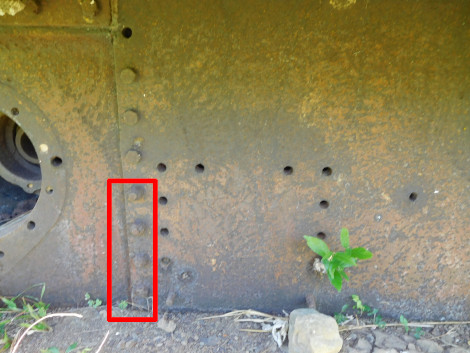

Since Jim Goetz went a long way to examine SN 26908, we thought we would include a couple more of his photographs. In the realm of extreme Sherman minutia, the image on the left shows the "nut out" installation of the lower 4 bolts (circled) where the differential housing attached to the lower hull. This was done after reports that the driver's pants were snagging on the ends of the lower bolts as he operated the foot controls. On the right, we see one of the fittings added to the hull sides of 26908, presumably to hold lumber "armor." Note that traces of the name "Jezebel" can still be seen painted on the applique plate. The lumber seen in some period photos appears to have consisted of various widths of "2 x" [about 1 1/2 to 2 inches wide] planks, such as shown in the inset. The M4A2 in the inset served with C Company, 4th Marine Tank Battalion and was filmed on Namur on the 1st or 2nd of February, 1944. We think there is a chance that this tank, "Speed" Number 24, may be SN 26908.


Official Lend Lease figures for M4A2(75) shipments to the Soviets vary a little, but for our purposes, we will use 1991 as our base, with 211 being from the Second Protocol, all allocated in September, 1942, and 1780 from the Third, allocated July, 1943 through May, 1944. The 1942 allocations would have been early production M4A2s, most or all with direct vision. We believe that most of the 1943 allocations would have been produced from the 2nd half of 1943 through the end of M4A2(75) production in May, 1944. Consequently these would have had many of the modifications introduced throughout that period, culminating with the transition to the large hatch hull towards the end of 1943. We estimate that about 800 of the Third Protocol Shermans would have been large hatch M4A2(75)s, which leaves approximately 980 small hatch. Most of the few available WW II photos of these tanks were taken by the Germans, and show destroyed units, with the large hatch models appearing far more frequently than the small hatch. The uncaptioned photos above are from a series showing a pair of KO’d small hatch Fisher built M4A2(75)s. In some of the images, their turret numbers are in similar “fonts,” and can be seen as 55 and 56, suggesting that the tanks were from the same unit and were photographed on the same day. We believe their appearance would reflect that of most of the Fisher small hatch M4A2(75)s that the Soviets received. Both tanks have sharp nosed E8543 differential housings, and “no pistol port” turrets, features which began to appear in production at Fisher in the Summer of 1943. Both tanks have the Quick Fix (1) and the driver’s hood armor (2) modifications. Along with the gun travel lock (3), these were reported to have been introduced at Fisher in August, 1943. Both have periscope guards (4), and commander’s vane sights (5), which are stated to have been introduced in September. At some point, a filler cap for “engine oil gauge” (6) was introduced in production on all M4A2s. We have yet to come across any documentation, but the earliest it appears in a photo of a unit with a known good Serial Number is September, 1943. Note the absence of the 2 inch smoke mortar from the turret. We don't find evidence that Fisher ever installed that on their small hatch M4A2s.

The photo above is captioned, "Italians of Barbiano greet NZ tanks as they arrive in the township after its capture by NZ troops. Photograph taken by George Kaye, 10th of April, 1945." Although no tactical markings are visible, it is thought that this M4A2(75), or Sherman III, served with the 20th [NZ] Armoured Regiment which was operating in this area at the time in support of the 2nd New Zealand Infantry Division. Of interest is that this tank, which is obviously a Fisher, shows many modifications not generally seen on Commonwealth Sherman IIIs. Indeed, Leife Hulbert, our resident expert on CW Shermans, says that this photo is the only British/Commonwealth Fisher he has come across to date seen with the sharp nosed E8543 differential housing. Like the Soviet Shermans of the previous caption, this tank has the Quick Fix, the driver’s hood armor and the gun travel lock, modifications reported to have been introduced at Fisher in August, 1943. In addition it has both the periscope guards and the commander’s vane sight, which are stated to have been introduced in September. The British were allocated 463 remanufactured M4A2(75)s, July through August, 1944, and they would have incorporated the mods seen here plus a few more. However, these would have been mostly older, 1942 production M4A2s. The E8543 differential and the other mods would lead us to conclude that the NZ Sherman III would have been accepted September, 1943 or later, and would reflect the final appearance of a new production, Fisher small hatch M4A2(75). We would point out that the last CW allocations of M4A2s in 1943 were 17 in August and 1 in September. After that, remaining supplies of new M4A2(75)s were allocated to the Soviets and USMC. Photo DA-09146-F courtesy of Alexander Turnbull Library.
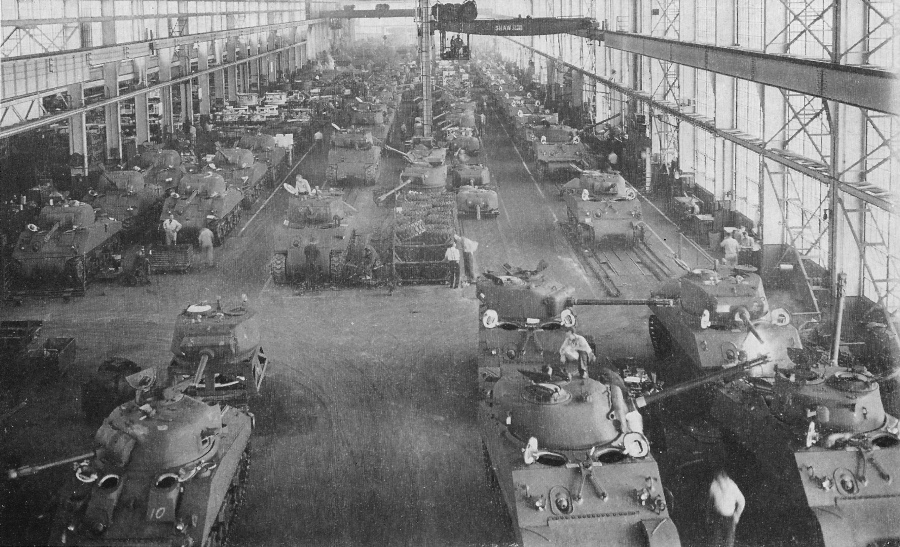
The final Lend Lease allocations of the M4A2(75) were for 463 units to the British from July through September, 1944. In addition, France was allocated 20 in October, 1944. The evidence suggests that these were tanks that had been used by training units in the US, and were gathered up for remanufacture at the request of the British, who continued to prefer 75mm over 76mm Shermans. The Fisher Tank Division remanufactured 218 M4A2(75)s from April through July, 1944, while Federal Machine and Welder did another 317 from April through November, 1944. Based on notes from a 31 January, 1944 meeting held at Mr. Del Harder's office at Fisher, this program was delayed somewhat by the slow progress in collecting and delivering the tanks, along with the Ordnance Department's last minute addition of 33 modifications. It is noted that motors were to be new (i.e. spares), or reconditioned units done at Red River Arsenal. There was obviously some tension when the manufacturers stated that the time required to implement a number of the additional changes would be between 90 and 120 days, and the Army officials said that this unacceptable. The issue appears to have been one of materials priority, with the builders saying that they would gladly implement certain of the mods immediately, if the government would provide the parts immediately and GFI [Gov't. Free Issue]. In any case the program didn't kick off until April, 1944, and it would appear that most of the additions were incorporated. These included fittings for stowage of the .50 caliber MG on the turret bustle, the blanket roll rack, periscope guards, a gun traveling lock, and an improved air cleaner and cooling system, presumed to be the Barber-Colman system introduced in new production at the beginning of 1944. The idea was to make these tanks as close to current standards as possible. With that in mind, the government had added "Hatch over Loader," but this is marked "Cancelled" in the doc. "Periscope Guard-(Armored)" is marked "To be cancelled," but we would note that the gunner's armored periscope guard does appear in some of the few period photos. This could serve as a differentiator since the armored periscope guards would NOT have been available to Fisher or any of the other manufacturers in the final months of new small hatch M4A2 production. Many of these tanks would have been 1942 production with M34 Gun Mounts, and one of the "last minute" changes added was "Telescope Mount, Improved, with Adjuster." This may have been the M34 Gun Mount modified to incorporate the M70 Telescope. If so, "Mr. Harder refused to incorporate and assume responsibility for proper operating of gun mounts due to modifications requiring welding on machined castings." Again the few photos suggest that the tanks were retrofitted with M34A1 gun mounts instead. The photo above is undated and not the best quality, but shows the factory floor at Fisher Tank most likely in May, 1944. We based this on the fact that the new production Shermans, M4A3E2s, M4A3(75)Ws and M4A2(76)s have inboard lifting rings and lack the ventilator cover between the drivers' hatches. It is somewhat surprising that the remanufactured tanks (on the left) have not yet been installed with the "Quick Fix" side applique plates at this late stage.


Here we have a pair of Canadian M4A2s photographed at the intersection of Steentilstraat & Oosterstraat during the liberation of Groningen, The Netherlands on 15th April, 1945. In the foreground of the photo on the left we can see T-229880, which has both the Quick Fix and drivers' hood applique modifications, while the tank in the background has "high" turret lifting rings. The photo on the right shows the second M4A2, T-229994. The angle of the drivers' hood applique plates suggests that this tank was a direct vision Sherman, while the fabricated antenna bracket would tend to identify it as an early production Fisher. In the inset we can see that this tank has the gunner's armored periscope cover installed. One of the L-shaped brackets for the AA machine gun barrel stowage is visible on the Sherman in the background. These tanks were probably recently issued, as they don't appear to have any tactical markings. The crews are in "combat mode" with the drivers' hatches buttoned up, and the commanders' hatches only slightly ajar. Despite this, civilians can be seen standing around, and some flowers have been tossed on the tanks, along with messages chalked on the sides.

The above shows the same scene from the rear. Again it can be observed that the Sherman on the right has a turret lifting ring in the "high" position. The Barber-Colman exhaust deflectors, blanket roll racks, and machine gun stowage fittings on the turret bustles lead us to conclude that these are remanufactured tanks. We would note that both tanks are lacking the typical British style bustle stowage boxes installed on many Commonwealth Shermans when processed before issue. Perhaps these were omitted because it would have been necessary to remove and/or relocate the mg stowage fittings? The Fort Garry Horse, a veteran Canadian Armoured Regiment that landed on D-Day, claim credit for the liberation of Groningen, and indeed both T-229880 and T-229994 are listed in their Vehicle Rosters in the Summer of 1945. Counting heads suggests that the British remanufactured M4A2s were assigned T Numbers in the range 2296XX through to 230086, which is the highest we have recorded, and also listed as an FGH Sherman.

With the exception of the M4A4, Shermans were built with a dataplate affixed to the wall to the left of the driver's seat. Unfortunately, we have not as yet come across an example of an intact and readable Fisher M4A2 plate. What we have noted on the few survivors is that the Serial Number is stamped inside the frame that held the dataplate (inset), such as seen on the French Monument M4A2 "Romilly," Serial Number 9008.


Fisher built Shermans have been noted to have the tank's Ordnance Serial Number stamped into both of the rear towing lugs, as seen on the historic French M4A2 "Valois," SN 26875.
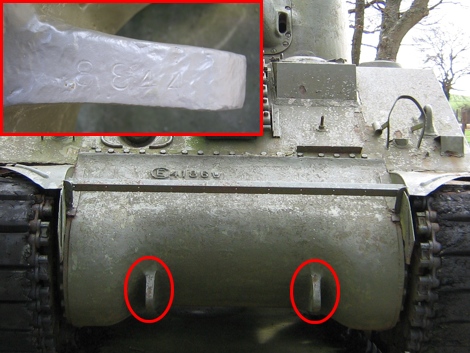

The
Ordnance Serial Number has been seen stamped on both tow lugs of the
E4186 differential housings on some surviving Fisher M4A2s such SN 8844
on the left above. On those with the later E8543 differential housings,
the SN with an "S" prefix, presumably for "Serial Number," has been
noted to be stamped on both edges of the diff, as shown on SN 26830 on
the right. A number of surviving Shermans have had their original diffs
replaced either during the course of their service or during later
restorations, so we take the serial number stamped on the rear towing
lugs to be the original if the serial number on the differential housing
does not match.

Fisher built Shermans have also
been noted to have what we consider to be a loose build sequence number
stamped on the left front (driver's side) of the hull. In the case of
the Canadian combat veteran, "Bomb" Serial Number 8007, on display in
Sherbrooke, QP, it can be seen as "898." This is actually an exact
build sequence number, that is to say that, by our math, "Bomb" would
have been the 898th M4A2 built by Fisher Body (November 1942). We
would observe that the "side numbers" of the few surviving examples are
not always in sync with the serial numbers. They appear to have
fallen out of sync further along in production, hence our
characterization as "a loose build sequence number." At any rate,
the "side number" can be useful in the event the tank's serial number
can't be found. In cases where there is not a lot of paint build-up,
the same "side number" has been observed stamped on the engine
deck door hinges of some Fisher built M4A2s and M10s. The photo on the
right shows it on "Bomb." We continue to investigate with the notion
that Fisher might have stamped the "side number" on the hinges of most
or perhaps all of their Shermans. Of course, there have been
instances on some survivors where the numbers on the engine deck door
hinges do not match the "side number", and we assume that, in those
cases, the doors may have been replaced.
